Chapter 9—
Willaert's Protégés at San Marco—
Codification, Dissemination, and Subversion
By the mid- to late forties Willaert was producing music more and more slowly. He printed his last sizable cache of madrigals (five) in Scotto's edition of Rore's Third Book of 1548, and this after a dry spell of four years. During the same time the pursuit of madrigals by vernacular connoisseurs in Venice like Antonio Zantani, Gottardo Occagna, and Domenico Venier was rising with the increased production of what I have called dialogic volumes around midcentury. With "the good times of la Pecorina" nearly gone, these connoisseurs could have little chance to fill their shelves and parlor rooms with new music by the aging chapelmaster. And Rore — chapelmaster in his own right at Ferrara by the spring of 1546 — must have been all but inaccessible.
Willaert's young corps of students at San Marco was eager to fill the void. Girolamo Parabosco had been studying with Willaert since about 1540.[1] Perissone Cambio made his way to the city by 1544 and had joined the chapel by 1548. His tutelage under Willaert probably started earlier, since he was already skilled at Willaertian composition by 1544-45. Baldassare Donato arrived perhaps only slightly later than Perissone (to judge from the raise in the nominal salary he received as a zago, a boy singer in training, early in 1546).[2] As we saw in Chapter 7,
[1] H. Colin Slim notes that Parabosco may have studied with Willaert as early as the late 1530s, for in 1540 two of his ricercars appeared along with Willaert's in the instrumental print called Musica nova; see Musica nova accommodata per cantar et sonar sopra organi; et altri strumenti, composta per diversi eccellentissimi musici. In Venetia, MDXL, ed. H. Colin Slim, foreword by Edward E. Lowinsky, Monuments of Renaissance Music, vol. I (Chicago, 1964), pp. xxix and passim. According to Zarlino's Sopplimenti musicali (Venice, 1588; facs. ed. Ridgewood, N.J., 1966), Parabosco was present in Venice by at least 1541 (p. 326).
[2] See Mary S. Lewis (who learned it from Jonathan Glixon), "Rore's Setting of Petrarch's Vergine bella: A History of Its Composition and Early Transmission," Journal of Musicology 4 (1985-86): 371 n. 13, and Ongaro, "The Chapel of St. Mark's at the Time of Adrian Willaert (1527-1562): A Documentary Study" (Ph.D. diss., University of North Carolina at Chapel Hill, 1986), p. 125 and Document 164.
Donato was enough in his teacher's graces by 1547 to have been given the tasks by the Procuratori of acting as Willaert's scribe and keeping him "occupied in composing."[3] And Francesco Londariti (called "il Greco"), who attended Zantani's gatherings along with the other three, joined the chapel in June 1549.[4]
For musicians at the chapel, training in counterpoint formed an essential part of a general musical education. Counterpoint taught singers how to adapt part music according to the norms of musica ficta, how to make the correct consonances and progressions, and how to improvise over a cantus firmus — a practice alluded to by the Venetian dialect author Andrea Calmo in a letter to Willaert.[5] A knowledge of counterpoint (as Margaret Bent has argued) was thus virtually as necessary for singing as for composing. For chapel members, Willaert's counterpoint lessons were part of the weekly agenda, and singers who ignored them (like one Zorzi Carpenello) risked censure from the upper echelons of the church.[6] It did not follow that all performers of part music were also composers, yet one of the most significant coincidences in the social, aesthetic, and economic conjunctures by which vernacular music emerged in Venice was that Willaert's three main disciples excelled in both roles. All but Londariti published solo madrigal books at the same time as they won considerable fame as performers.[7] These composer-performers were among the most successful entrepreneurs in the private worlds of Venetian music making, even though none of them seems to have formed the elitist pacts with patrons that Willaert and Rore did. On the contrary, what distinguished the new generation were careers marked by struggle, entrepreneurship, and mobility. Unlike Willaert's and Rore's prints of Petrarchan sonnet settings, theirs were interlaced with numerous lighter-weight settings of madrigals, canzone stanzas, ballate, and ottave rime, and all of them were underwritten by dedicatees. By recasting elite styles in sunnier guises, they disseminated them in forms that could better appeal to commercial consumers.
[3] Donato was also to notify the bureaucracy of any new works that Willaert had composed (see Chap. 7 above, n. 14).
[4] Ongaro, "The Chapel of St. Mark's," pp. 128-29 and Document 180.
[5] "La vostra componidura amice dulcissime è destilà a sete lambichi, e purgà in nuove acque, e affinà a quatro fuoghi, propio alla condicion de l'Aurum potabilem; mo vegnimo sun questa difficultae, che puochi la sà resolver, tanto la xe difficile, e contrapontizar all'improviso del canto fermo, altro cha dir vilote, ni zorziane, ni barzelete" (Your compositions are distilled in seven stills, purged in fresh water, and sharpened over four fires, just like aurum potabilem. But let's turn now to this difficult business, so hard that few can manage it, of improvising a counterpoint over a cantus firmus: how much harder than improvising villotte, zorziane, or barzellette ); Delle lettere di M. Andrea Calmo libro terzo. Nel quale si contiene varij, & ingeniosi discorsi filosofici, in lingua Veneta composti, 4 vols. (Venice, 1572), vol. 3, fol. 30.
[6] See Ongaro's report of an interrogation of Willaert by one of the Procurators, Giovanni da Lezze, made on 8 August 1538, "The Chapel of St. Mark's," pp. 105-9 and Document 343. For an argument that studying counterpoint in the chapel ranks was an advanced, rather than elementary, training for adult singers, see the interpretation offered on pp. 109-11. For Bent's views on the necessity of counterpoint both for correct composing and singing see "Resfacta and Cantare Super Librum, " JAMS 36 (1983): 371-91, esp. p. 377.
[7] Although Parabosco was hired as an organist, he was clearly a good salon singer (see n. 8 below). Londariti's surviving madrigals are negligible in number — four, plus two napolitane — though he produced a good deal more sacred music. See the brief entry "Londariti, Francesco," in The New Grove 11:142.
Girolamo Parabosco
"The rest of us are worth nothing. Who composes music? Parabosco. Who writes poetry? Parabosco. Who sings, who has a thousand talents? Parabosco. Pazienza!"[8]
So raves Parabosco's fictive rival Claudio Veggio in Doni's Dialogo della musica after the interlocutors have just sung three of Parabosco's pieces and then gone on to hear him recite some of his sonnets. At the time Doni wrote the Dialogo, the young Piacentine was only about twenty. He had learned keyboard from his father, organist at the cathedral of Brescia from 1536, before going to Venice to study composition with Willaert. Around the time he arrived in Venice a ricercar of his was published in Willaert's instrumental Musica nova of 1540, four years before the Dialogo appeared, and shortly thereafter he published his first madrigal, the three-voice Ben madonna a che siamo, in Constanzo Festa's Primo libro de madrigali a tre voci . . . novamente ristampati of 1541.[9] Yet Ben madonna is no new-styled setting but a diminutive madrigal on a text rhymed aABccDD that Parabosco rendered with almost childlike naïveté, outfitting it in a quasi-frottolistic dress suited to its simple complaint. In keeping with Festa's settings a 3, Parabosco's is largely homophonic, its voices pulling apart only occasionally in imitative or staggered entrances before moving into simultaneous, or near-simultaneous, cadences to end each verse. In this sense his reading is resolutely prosodic, matching single melodic phrases to each poetic line with little concern for syntax and even breaking syllables in midword in the way of light and parodistic genres ("ch'io mo-, ch'io mora").[10]
Parabosco may well have been the only one of Willaert's three main disciples who had already arrived in Venice by the late thirties to the early forties when Strozzi and Capponi were both encamped there, and who had begun by practicing a decidedly pre-Musica nova art. This may help explain why so much variety is found among his juvenilia from 1544, four in Doni's Dialogo della musica and one in Rore's Secondo libro de madrigali a cinque voci. Of these, two set poems by Petrarch (the octave from the sonnet Giunto m'ha Amor fra belle e crude braccia, no. 171, and stanza seven from the sestina Nessun visse giamai più di me lieto, no. 332); one the octave from a sonnet by the Florentine Lodovico Martelli (Pur converrà ch'i miei martiri amore );[11]
[8] "Noi altri ci siam per nulla; chi compone i canti, Parabosco; chi fa versi, Parabosco; chi suona, chi ha mille virtù, Parabosco. Pazienza" (Antonfrancesco Doni, Dialogo della musica, ed. G. Francesco Malipiero and Virginio Fagotto [Vienna, 1965], p. 190). Another edition of the Dialogo is that of Anna Maria Monterosso Vacchelli, L'opera musicale di Antonfrancesco Doni, Instituta e monumenta, ser. 2, no. 1 (Cremona, 1969).
[9] The latter work may have appeared even earlier since the Festa print is called "ristampato" on Gardane's title page, but the original edition is now lost (see Fenlon and Haar, The Italian Madrigal, p. 231). A mod. ed. of Ben madonna is included in Gerolamo Parabosco, Composizioni a due, tre, quattro, cinque e sei voci, ed. Francesco Bussi (Piacenza, 1961), pp. 5-6. For the ricercar see Musica nova accommodata per cantar et sonar sopra organi, ricercar "Da pacem," pp. 123-24. For further on Parabosco's biography see the citations in Chap. 1 n. 38 above.
[10] For Zarlino's proscription against this see Le istitutioni harmoniche (Venice, 1558), p. 341.
[11] For the Petrarch settings see the eds. in Doni, Dialogo della musica, pp. 64-69 and 123-28, respectively. For Pur converrà see idem, pp. 58-63, and Parabosco, Composizioni, pp. 7-11; for the poem see Lodovico Martelli, Rime volgari (Rome, 1533), fols. 20-20'.
one set a ballata by the Venetian Giovanni Brevio (Cantai mentre ch'io arsi del mio foco );[12] and the fifth — the one that appeared in Rore's collection — set a gloss on Petrarch's sonnet Anima bella da quel nodo sciolta.[13] These texts anticipate the predilection Parabosco, or his patrons, had for established poets. In his only printed madrigal collection, Madrigali a cinque voci of 1546, every poet can be named, save one, a distinction not shared by any of the other collections by Willaert's students (see Table 9). By 1544, in keeping with this high literary tone, Parabosco's madrigals also began to fashion themselves in response to Willaertian declamatory ideals: largely syllabic, carefully accentuated, complexly textured, ingeniously articulated, expressively colored, and newly sensitive to the subtleties of rhetoric.
Nevertheless, in altering or abridging a number of the texts he set, Parabosco eschewed the absolutist demands for perfect literary integrity that Willaert and Rore were making in the 1540s. His Anima bella irreverently tacks a newly written quatrain onto a quatrain by Petrarch. Another setting, Niuna sconsolata (in the Madrigali a 5 ), begins a thirteen-line madrigal by quoting the three-line ripresa from Boccaccio's ballata of the same incipit.[14] Such texts move between standard ploys of imitation and something more like revision. In line with the radical manipulations they work on preexistent verse, Parabosco's other settings often truncate poems, in some cases drastically. At other times, they extract stanzas from canzoni and sestine or take octaves from sonnets to set either in one part (as in Giunto m'ha Amor ) or in two (as in I' vo piangendo from the Madrigali a 5 ). Truncations of extended lyrics were of course a typical corollary of the fairly freewheeling attitudes madrigalists across Italy often held about the texts they set, and it was precisely those attitudes that were called into question by the new reverence with which Venetians began treating vernacular poetry. Perhaps it is no surprise that a poet and brash, self-made man of culture like Parabosco would not fully have shared them.
Parabosco's music written for 1544 collections shows less sweeping affinities with Willaert's practice than that from 1546. The truncated Giunto m'ha Amor set a 4 forms a case in point and a revealing basis for comparison with Parabosco's later work. Giunto m'ha Amor does not model itself on Willaert's five-voice setting from the Musica nova but unfolds in a series of Willaertian expositions on overlapping syntactic units.[15] Unlike Willaert, Parabosco balanced the claims of syntax against those of versification, rather than calibrating cadences strictly according to words' grammatical weight and order. The differences are notable in Willaert's and Parabosco's settings of vv. 2-3 of Giunto m'ha Amor, both of which are marked by
[12] Modern eds. in Parabosco, Composizioni, pp. 12-24, and Doni, Dialogo della musica, pp. 176-88; for the poetic source see Table 6, no. 1.
[13] Modern ed. in Einstein, The Italian Madrigal 3:151-54.
[14] Cf. Boccaccio, Decamerone, ed. Mario Marti, 5th ed., 2 vols. (Milan, 1984), 1:262, and Girolamo Parabosco, Il primo libro dei madrigali, 1551, ed. Nicola Longo (Rome, 1987), p. 113.
[15] Neither does Parabosco's setting show any relationship to Girolamo Scotto's setting of 1542, whose declamation is often oblivious to textual accent; see Madrigali a quatro voci di Geronimo Scotto con alcuni alla misura breve, et altri a voce pari . . . Libro primo (Venice, 1542), no. 20.
strong articulation owing to the deployment of three grammatical clauses over four poetic lines (as marked below in the version from Willaert's setting).
[1] Giunto m'ha Amor fra belle e crude braccia, [1] Love has brought me within reach of lovely, cruel arms
Che m'ancidono à torto, [2] e s'io mi doglio That unjustly kill me, [2] and if I complain
Doppia 'l martir, [3] onde pur, com'io soglio, he redoubles my torment; [3] thus still, as I am wont,
Il meglio è ch'io mi mora amando e taccia. it is better that I die loving and be silent.
In Petrarch's text all three syntactic parcels are effectively displaced from the versification, the first ending in the middle of v. 2 and the second in the middle of v. 3. For Willaert, these clauses determined the shape and layout of the syntactic counterpoint, as seen in the articulations he makes in the middles of those verses (See Ex. 33a beginning with v. 2). "E s'io mi doglio" and "onde pur" generate new soggetti (albeit internally varied ones) and, for the most part, new pitch planes. Willaert's setting separates each clause with rests, projecting the enjambments and practically effacing the poetic prosody. By contrast, Parabosco's setting virtually inverts Willaert's hierarchy of syntax and versification, closing off "Che m'ancidono a torto" with a simple cadence that is weak by comparison with the four-voice diminished clausula in mi ending "e s'io mi doglio" (Ex. 33b; compare mm. 8 and 10) and unfolding a separate exposition on "Dopp'il martir." Parabosco's ostensibly syntactic treatment thus masks what is really a poetic one, while Willaert treats the text almost as though it were prose.[16]
Put another way, Parabosco parsed text more like song than prose-based polyphony, consistent with his more lyric declamation. Not only are his melodies prone to free melismatic flights reminiscent of Rore's (see, for instance, the melisma in the tenor on "soglio," Ex. 33b, mm. 15-18), they are also more extended than Willaert would allow. Willaert, for example, set the r-, o-, and consonant-laden "e rompr'ogn'aspro scoglio" with unvaried austerity, reiterating a series of quarter notes (Ex. 34a), while Parabosco broke up the line to lyricize at least one voice (again, the tenor) with florid turns, graceful dotted notes, and leaps (Ex. 34b). In this sense Parabosco's Giunto m'ha Amor, and other settings of his from 1544, indicate he was under the sway of Rore's First Book. Given Veggio's suggestion that Parabosco was a fairly proficient singer — Veggio mentions it in a world in which virtually everyone could sing — and given his acquaintance with Ruberto Strozzi and the whole circle of those close to Willaert and Capponi, we can guess that Parabosco knew Rore's madrigals from having sung them in salons himself. Two of his madrigals can be located specifically within Rore's madrigalian production: Anima bella, the Petrarchan adaptation that had its debut in Rore's Second Book,
[16] For further on Willaert's setting, see Howard Mayer Brown, "Words and Music: Willaert, the Chanson and the Madrigal about 1540," in Florence and Venice, Comparisons and Relations: Acts of Two Conferences at Villa I Tatti in 1976-1977, vol. 2, Il Cinquecento, ed. Christine Smith with Salvatore 1. Camporeale (Florence, 1980), pp. 225-28.
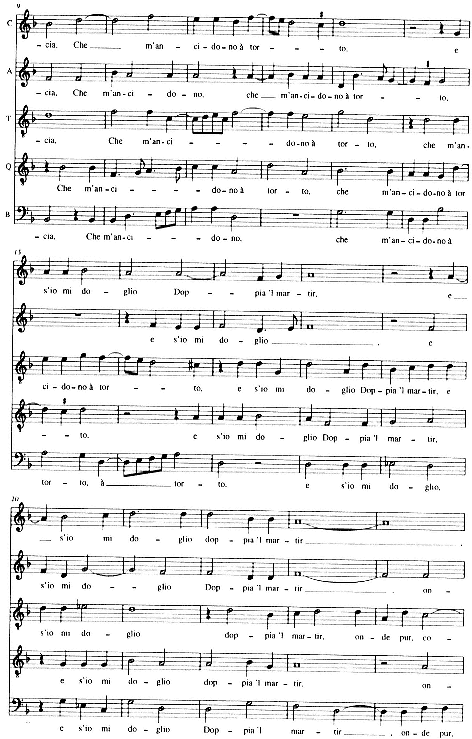
Ex. 33A.
Willaert, Giunto m'ha Amor fra belle e crude braccia (Petrarch, no. 171),
mm. 9-24; Musica nova (Venice, 1559), no. 11.
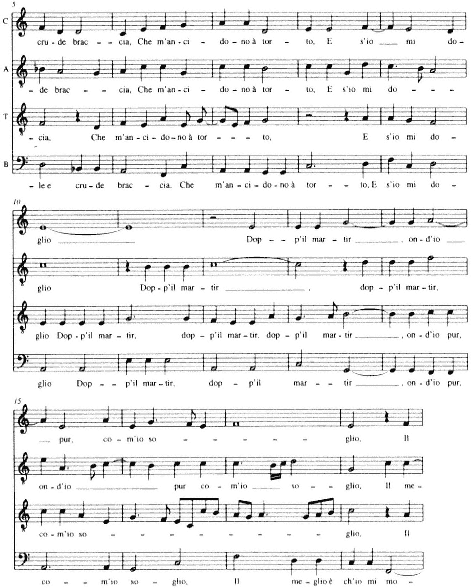
Ex. 33B.
Parabosco, Giunto m'ha Amor fra belle e crude braccia (Petrarch, no. 171),
mm. 5-18; in Antonfrancesco Doni, Dialogo della musica (Venice, 1544), fol. 14
in cantus.
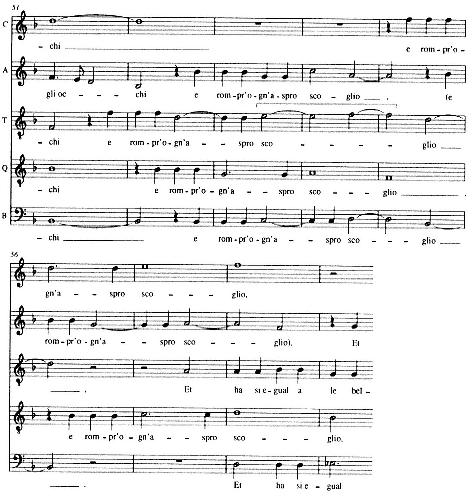
Ex. 34A.
Willaert, Giunto m'ha Amor fra belle e crude braccia (Petrarch, no. 171),
mm. 51-59; Musica nova (Venice, 1559), no. 11.
and the six-voice setting of Brevio's Cantai mentre ch'io arsi. The latter shows extensive similarities with the setting Rore had published at the head of his First Book, from the same signature and final (G mollis) and overall length (104 breves compared with Rore's 105) to numerous details of interpretation.
Cantai mentre ch'io arsi is a ballata, organized sonnetlike in fourteen hendecasyllabic verses, whose grammatical articulation coincides exactly with its formal scheme.[17]
[17] I give the poem as it appears in Parabosco's setting. Bussi mistakes the poem for a sonnet and therefore presents a wayward analysis of Parabosco's setting (Umanità e arte di Gerolamo Parabosco: madrigalista, organista, e poligrafo [Piacenza, 1961], p. 127). The form of Brevio's ballata is exactly the same as that of Petrarch's ballata no. 63, "Volgendo gli occhi al mio novo colore": a four-line ripresa (ABBA), a pair of three-line mutazioni (CDE/DCE), and a four-line volta (EFFA), all in endecasillabi.
For Parabosco's complete setting, see the eds. cited in n. 12 above and for Rore's setting see his Opera omnia, ed. Bernhard Meier, Corpus mensurabilis musicae, no. 14, AIM, vol. 2 ([Rome], 1963), pp. 1-4.

Ex. 34B.
Parabosco, Giunto m'ha Amor fra belle e crude braccia (Petrarch, no. 171),
mm. 29-36; in Antonfrancesco Doni, Dialogo della musica (Venice, 1544), fol. 14
in cantus.
Cantai, mentre ch'io arsi, del mio foco I sang while I burned from the living flame
La viva fiamma, ov'io morendo vissi, Of my fire, whence I dying lived,
Benchè quant'io cantai e quant'io scrissi Although what I sang of and what I wrote
Di madonna e d'amor, fu nulla o poco. About my lady and love were nothing, or little. 4
Ma se i begli occhi ond'il mio cor s'accese But if the lovely eyes from which my heart burned
Del lor chiaro divin almo splendore Had not wrongly found me unworthy
Non m'havessero a torto fatto indegno, Of their bright, divine, life-giving splendor,
Col canto havrei l'interno e grave ardore With a song I would have made known
Agl'orecchie di tal fatto palese, My grave inner passion to those ears,
Che pietà fora ove alberga ira e So that there might be pity where anger and disdain
sdegno. now dwell. 10
Agl'amorosi strali fermo segno I would be a sure mark for the
Sarei, pieno di dolce aspro martiro, Amorous darts, full of bittersweet grief,
Ov'hora in libertà piango e sospiro: Where now in freedom I weep and sigh:
Ahi, pace in cor d'amanti non ha loco. Oh, peace has no place in the hearts of lovers! 14
The ripresa (vv. 1-4) encloses the ballata's life-death conceit in a single extended period, then elaborated in a complex if-then qualifier by the mutazioni (vv. 5-10). The mutazioni thereby culminate in the kind of rhetorical resolution usually reserved in a sonnet for the final verse, but typical at this point in a ballata. In the third and last clause the volta (vv. 11-14) provides by comparison more modest thematic closure through a distant trope on what has gone before, while still strengthening the poem's end by reintroducing the A rhyme that frames the ripresa.
Both Rore and Parabosco avoided dividing the ballata into two parts after the ripresa but marked its chief formal divisions with strong cadences. Like most of his other settings, Rore's is extensively articulated by means of cadences at every verse ending as well as at some of the internal caesurae (vv. 2 and 3). More strongly than Parabosco's setting Rore's reinforces the structural breaks at vv. 4 and 10 with two successive cadences for each (mm. 29 and 32 and mm. 61 and 64, respectively). Parabosco's setting, by contrast, uses few cadences. The first one, a major sixth to octave on C fortified with a descending fifth in the bass, appears only at the end of the ripresa (m. 31), with a similar one on B-flat (minor third to unison, now with a rising fourth in the bass) at the end of the mutazioni (m. 72).
While paying less attention to large formal divisions, Parabosco apparently emulated some of Rore's declamatory rhythms (as at the opening). What is more, he took over voicings and intervals from a striking contrapuntal passage on "dolce aspro martiro" from v. 12 that absorbs Brevio's Petrarchan oxymoron of bittersweet grief into successions of parallel sixths (Exx. 35a and 35b).[18] Especially noteworthy in connection with Parabosco's imitation is that Rore's setting deploys parallel six-three chords first in the upper voices (mm. 75-76), later shifting them to altus and bassus in staggered declamation and writing the last two intervals as major (mm. 79-80). In so doing Rore introduced dissonance in a mild way but accentuated it with the spiky major seventh struck on "aspro" (E-flat and d, m. 80 — recall Zarlino's dicta on parallel motion and major intervals). Both passages resemble Willaert's exposition of the incipit "Aspro core e selvaggio, e cruda voglia" (Chap. 7, Ex. 16), which Parabosco himself imitated in a later setting (Ex. 38 below), as well as Rore's own apparent imitation of Willaert's exposition in setting the line "Sgombrino l'altre voglie aspr'e selvaggie" from Sfrondate, o sacre dive (Chap. 8, Ex. 32). Parabosco made similar use of parallel six-three chords in setting v. 12 from Solo e pensoso, "Ma pur sì aspre vie nè sì selvaggie," (Madrigali a 5; see Ex. 36). The entire complex of passages thus par-
[18] On Willaert's use of the six-three chord and parallel sixths as mild dissonances, see Armen Carapetyan, "The Musica Nova of Adriano Willaert: With a Reference to the Humanistic Society of 16th-Century Venice" (Ph.D. diss., Harvard University, 1945), pp. 172-73 and passim.
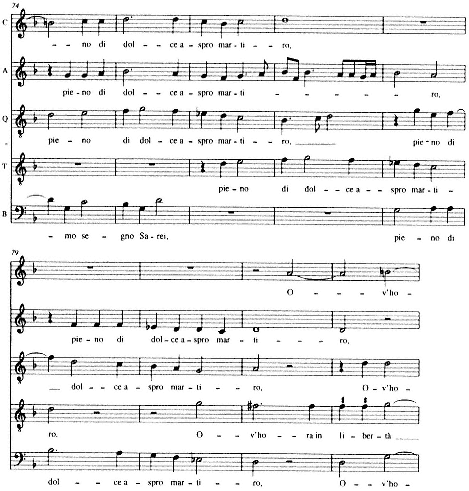
Ex. 35A.
Rore, Cantai mentre ch'i arsi del mio foco (Giovanni Brevio), mm. 74-82;
Madrigali a 5 (Venice, 1542), no. 1.
ticipates in a single musical topos that Venetian composers cultivated for expressions of harshness and wildness — a topos whose roots probably lie in Willaert's Aspro core and possibly in Rore's Cantai mentre ch'i arsi as well.[19]
The indebtedness of Parabosco's Cantai mentre ch'io arsi to Rore's setting is clearest at mm. 80-84, where it intermittently adopts Rore's parallel sixths and six-three chords when delivering "martiro" (Ex. 35b). Parabosco also adopted Rore's disposition of the text in semichoirs, high, then low (though his are more homorhythmic), and matched Rore's rhythmic declamation almost exactly (compare Rore's cantus at mm. 74-77 with Parabosco's at mm. 79-81). The only other
[19] We could also add to this group the parallel-third-filled exordium of Rore's Strane ruppi, aspri monti, alti tremanti (see Ex. 15).

Ex. 35B.
Parabosco, Cantai mentre ch'io arsi del mio foco (Giovanni Brevio),
mm. 78-84; in Antonfrancesco Doni, Dialogo della musica (Venice, 1544),
fol. 31 in cantus.
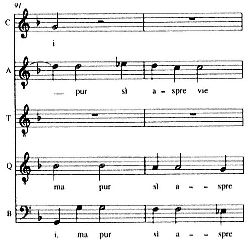
Ex. 36.
Parabosco, Solo e pensoso, i più deserti campi
(Petrarch, no. 35), mm. 91-92; Madrigali a 5
(Venice, 1546), no. 4.
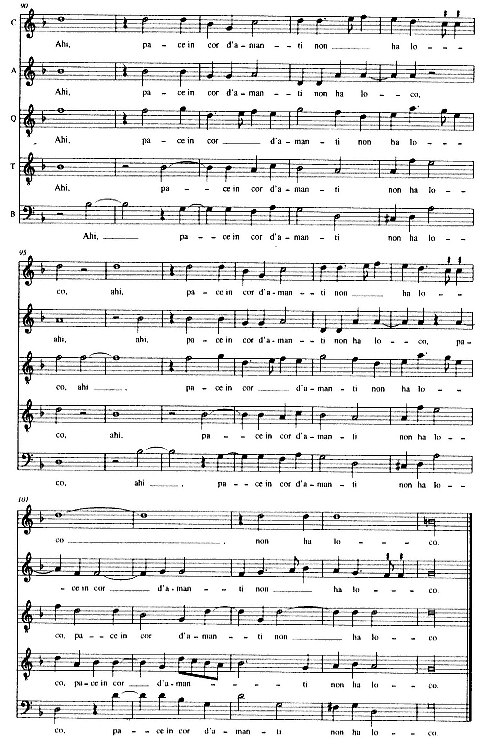
Ex. 37A.
Rore, Cantai mentre ch'i arsi del mio foco (Giovanni Brevio),
mm. 90-105; Madrigali a 5 (Venice, 1542), no. 1.
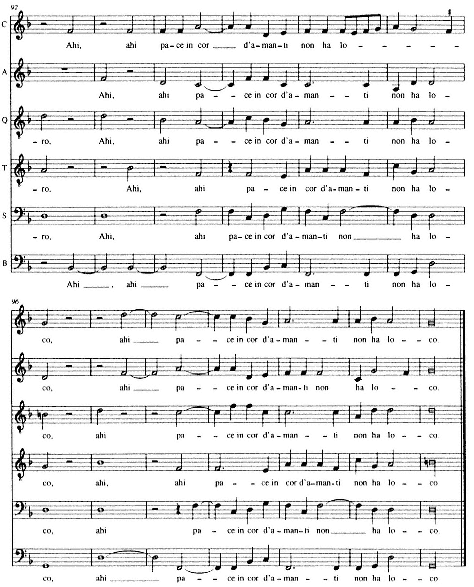
Ex. 37B.
Parabosco, Cantai mentre ch'io arsi del mio foco (Giovanni Brevio),
mm. 92-104; in Antonfrancesco Doni, Dialogo della musica (Venice, 1544),
fol. 31 in cantus.
passage that echoes Rore's so closely is the one setting the final aphorism, "Ahi, pace in cor d'amanti non ha loco" (compare Exx. 37a and 37b). Here the gasping "Ahi"s of both settings follow conventional practice, but Parabosco specifically emulated Rore in mm. 92-94 by staggering the vocal entrances in even semibreves over a B-flat in the bass.
Like Willaert's other students, Parabosco assembled his only madrigal collection, dedicated to Ruberto Strozzi, as a polyphonic miscellany.[20] All the poems in the Madrigali a 5 align themselves with a literary vernacular and most explore the amorous, metaliterary tropes of courtly Petrarchan verse. Apart from these commonalities, the book embraces a wide variety of poetic forms and registers across the whole upper range of the Ciceronian spectrum, approaching the heterogeneity of a book like Rore's second by excluding only comic, low, and dialect verse. Given the ideals of Ciceronian propriety that (I have argued) demanded this exclusion, it is no surprise that Parabosco's Madrigali a 5 bears little resemblance to his Lettere amorose, Lettere famigliari, I diporti, Il viluppo, or a host of other quasi-colloquial texts that he published between 1545 and his death in 1557. In most of these literary works Parabosco was openly eclectic, often droll, and at least a little subversive, evincing that self-serving blend of establishmentarianism and iconoclasm that defines the social climber in cosmopolitan Venice. Yet his one collection of madrigals was concertedly literary. None of Willaert's other students' books match Parabosco's in the amount of verse included that could also claim existence in literary venues. By concentrating on poems that carried enough cachet to have circulated with respectable lyric identities outside of music, Parabosco's collection could project a certain level of urbane sophistication. Perhaps to that end, the book avoids the provincial madrigalistic verse of his Piacentine countrymen Lodovico Domenichi, Bartolomeo Gottifredi, and even the wildly popular Luigi Cassola. It opens instead with two of Parabosco's own poems (a madrigal and a ballata-madrigal), then mixes in poems by more celebrated contemporaries — Baldassare Castiglione, Lodovico Martelli, Fortunio Spira, and Giovanni Mozzarello — among the many settings of Petrarch.
This chic vernacular eclecticism may explain why the book is built less on strictly high-styled, and especially "classical," sonnets than any of the other five-voice collections by Willaert's immediate pupils. Only six of its twenty numbers are complete sonnet settings (nos. 3, 4, 5, 7, 15, and 17), an additional two settings of sonnet octaves (nos. 13 and 14), as seen in Table 9. Of the nine Petrarchan settings (not counting Anima bella), only three are full sonnets, the rest partial sonnet settings (nos. 11 and 14) and stanzas drawn from canzoni (nos. 10 and 16) and sestine (nos. 9 and 12). About a third of the poems can be described as madrigals (nos. 1, 6, 8, 18, 19, and 20) or ballata-madrigals (no. 2).
[20] For the dedication see Chap. 2 n. 65 above. There is no mod. ed. of the collection at present.
| ||||||||||||||||||||||||||||||||||||||||||||||||||||||||||||||||||||||||||||||||||||||||||||||||||||||
(table continued on next page)
(table continued from previous page)
| ||||||||||||||||||||||||||||||||||||||||||||||||||||||||||||||||||||||||||||||||||||||||||
This idiosyncratic and rather paradoxical literary character — not conventionally elevated with a saturation of sonnets but nevertheless steeped in verse of recognizable pedigree — is matched by an equally unusual modal plan. Like many midcentury collections, the book is organized by cantus mollis and cantus durus as well as by final. The design that results seems to consist of four modal categories irregularly arranged without regard to ambitus: protus (nos. 1-4), tritus (nos. 5-8), deuterus (nos. 9-14), and tetrardus (nos. 15-20).[21]
Among the weightiest and surely the best-known setting in the Madrigali a 5 is Parabosco's Aspro cor. Since Helga Meier's study of 1969, it has been widely recognized that Willaert's students at San Marco emulated some of his Musica nova settings with borrowings and citations in their resettings of the same texts.[22] Given that Aspro cor is the only one of Parabosco's settings to have done so directly, it is not surprising that it took over Willaert's decorum, gravity, careful rhetorical shaping, and many of his specific readings more completely than did any of Parabosco's other settings. (We will see that Parabosco's colleagues also followed Willaert's practices most closely when actually modeling their settings on his.) Indeed, Parabosco's imitation of Willaert is arguably even more striking than Meier made out.[23] It quotes almost literally the extraordinary conception Willaert imposed on the first verse, even while replacing Willaert's G-durus eighth mode with a G-mollis transposed second (Ex. 38; cf. Ex. 16). It also adopts the descending melodic profile of the main motive and, like Willaert's, introduces the vocal groups in a three-plus-three arrangement (v. 1; v. 1 repeated — though with Parabosco's reduction to five voices, one voice sings v. 1 twice). And, most important, it borrows the six-five and four-three suspensions, the parallel major thirds mentioned by Galilei, and the concentration of major imperfect intervals that makes Willaert's setting so distinctive.
Yet Parabosco's departures from Willaert's version reveal even more than his borrowings, for on the whole he alleviated the austerity of Willaert's reading despite the harsh character of the poem. The tenor voice that begins the exposition imitates Willaert's motive, but its effect is undermined by the syncopated entrance of the alto a minim later and a new syncopation introduced in the cantus in mm. 2-3. These syncopations lighten the overall ethos of the passage while slighting considerations of textual stress and sense: the word "e" invites syncopation and prolongation in the cantus not for its accentual position or textual meaning but only to allow a more sensuous surface. Willaert's rhythms, by comparison, initially spaced a semibreve apart and wholly bound to the tactus through v. 1, help fix and maintain a more
[22] "Zur Chronologie der Musica Nova Adrian Willaerts," Analecta musicologica 12 (1973): 71-96.
[23] For a mod. ed. of the madrigal see Fünf Madrigale venezianischer Komponisten um Adrian Willaert zu 4-7 Stimmen, ed. Helga Meier, Das Chorwerk, vol. 105 (Wolfenbüttel, 1969), pp. 14-22. See also Meier's discussion of the madrigal in the preface to the edition, p. iv, and in "Zur Chronologie der Musica Nova, " p. 78. In Fünf Madrigale Meier points out how Parabosco's setting of Aspro core and Donato's setting of I vidi in terra angelici costumi and Liete e pensose made explicit references to Willaert's models by placing citations in exposed positions at the beginnings or ends of one of the parti.
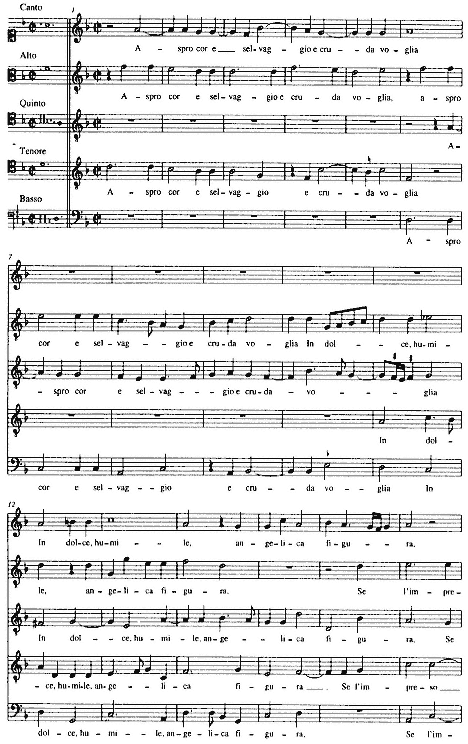
Ex. 38.
Parabosco, Aspro cor e selvaggio e cruda voglia (Petrarch, no. 265),
mm. 1-17; Madrigali a 5 (Venice, 1546), no. 3.
solemn pulse. The slow stepwise motion is hardly relieved by repeated minims, which do no more than fill in the basic semibreve structure.
In fact, Parabosco nearly reversed the role of metric stress and the discrete roles of tonic and agogic accents that Palisca found so striking a feature of Willaert's rendition, especially Willaert's staunch avoidance of syncopation in v. 1 and exploitation of it in v. 2; (see Chap. 7 n. 59). Furthermore, Parabosco's setting minimizes semantic contrasts between the verses by sprinkling the repetition of v. 1 with dotted semiminims while reducing the level of syncopation in v. 2. Despite the sdrucciolosa lilt in Petrarch's second verse, Parabosco had all the voices but the alto enter on the tactus. Similarly, he minimized the major-minor intervallic polarities that Palisca noted in Willaert's model by eliminating v. 2's emphasis on minor intervals. The only consistent way in which Parabosco realized these semantic dichotomies was through conventions that aligned textual meaning with melodic direction, moving largely downward for v. 1 and upward for v. 2.
In later passages Parabosco actually appropriated more completely Willaert's rhetorical delivery. At the beginning of v. 7, "Piango ad ogn'hor," for example, his setting exploits the same minor intervallic relationships with which Willaert's had personified the poet's weeping in the second quatrain (Exx. 39a and 39b).
Che quando nasce e mor fior erba e foglia, For when the flowers, grass, and leaves are born or die,
Quando è 'l dì chiaro e quando è notte oscura, When it is bright day and when it is dark night,
Piango ad ogni hor. Ben ò di mia ventura, I weep at all times. From fate,
Di Madonna, e d'Amor onde mi doglia. From my lady, and from Love I have much to grieve me. 8
Parabosco's setting concentrates on minor seconds and minor thirds, stressing the relationships B-flat/A and B-flat/G (cantus, tenor, quintus), as well as D/E-flat and E/F (altus). Beyond this, both settings take the beginning of v. 7 as a point of formal rupture by emphasizing the prosodic asymmetry it introduces into the quatrain. The nine and a half breves Willaert assigned to the first part of v. 7, "Piango ad ogn'hor" (as opposed to eight for all of v. 5 and seven for v. 6) magnify it rhetorically; Parabosco follows suit with eleven breves (compared with nine and eight and a half for vv. 5 and 6, respectively), and both set up its entrance with a perfect cadence and a registral shift to end v. 6 (aided in Willaert's case by a slowed surface motion).
Parabosco's setting continues to evoke the memorable textural, rhythmic, and tonal events that Willaert had deployed to mark the sonnet's major formal-expressive divisions in the sestet. But, here again, his setting mollified Willaert's effects. The voicing that opens Parabosco's seconda parte — three homophonic inner voices leading off, a fourth joining them after a semibreve, and the bass entering two and a half breves later — borrows from Willaert's, and the bass line in fifths comes from Willaert too (though Parabosco fails to sustain it beyond three chords). Parabosco
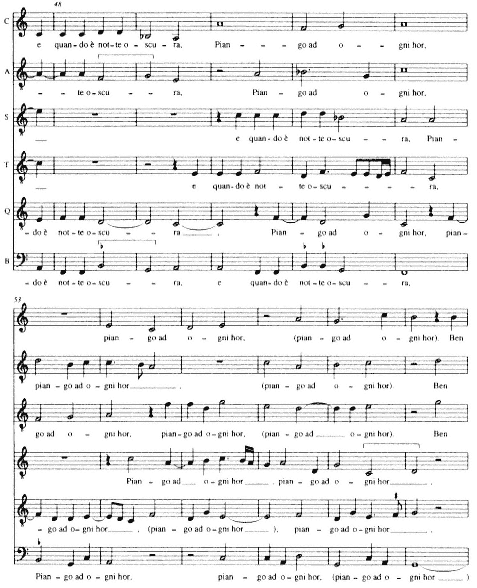
Ex. 39A.
Willaert, Aspro core e selvaggio e cruda voglia (Petrarch, no. 265),
mm. 48-58; Musica nova (Venice, 1559), no. 14.
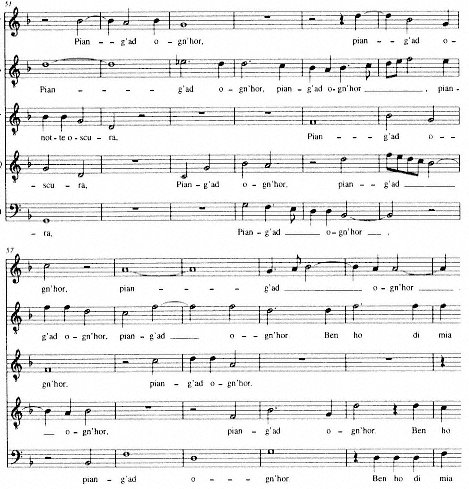
Ex. 39B.
Parabosco, Aspro cor e selvaggio e cruda voglia (Petrarch, no. 265),
mm. 51-62; Madrigali a 5 (Venice, 1546), no. 3.
used Willaert's rhetorical markers again at the beginning of the second tercet, "Non è sì duro cor che lagrimando," by isolating the first half of the verse, but here his motivic and tonal manipulations enervate the model even more (Exx. 40a and 40b). Willaert had started with a cross relation introduced by f-sharp in the sextus (third voice from the top, m. 103), which occurs within yet another brief circle-of-fifths progression, A to C, originating in the previous phrase. All but one of his approaches to "duro" hammers away in repetition figures that move up by major second. Parabosco treats the clause less uniformly, maximizing motivic and metric variety between parts where Willaert's setting pointedly avoids doing so, while underscoring Petrarch's verbal dissonance. His tenor leaps on "duro" to a mild minor sixth over the bassus (m. 105), resolving immediately to a perfect fifth. Three measures later (mm.

Ex. 40A.
Willaert, Aspro core e selvaggio e cruda voglia (Petrarch, no. 265),
mm. 103-10; Musica nova (Venice, 1559), no. 14.
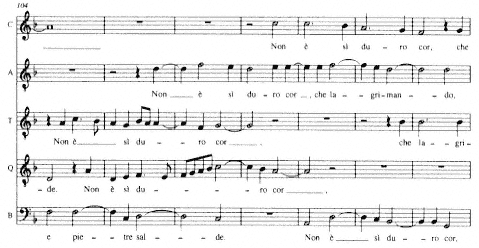
Ex. 40B.
Parabosco, Aspro cor e selvaggio e cruda voglia (Petrarch, no. 265),
mm. 104-10; Madrigali a 5 (Venice, 1546), no. 3.
108-9) suspended parallel sixths between outer voices invoke the madrigal's beginning.
Willaert's and Parabosco's treatments of the sonnet's final verse, "Ne sì freddo voler che non si scalde" (nor is there a will so cold that it cannot be warmed), resemble one another rhythmically but only confirm the sense that Parabosco largely refrained from riveting particular rhetorical effects to a single musical reading. In syncopating "freddo" with a dotted figure, Willaert's reading reinforced a level of
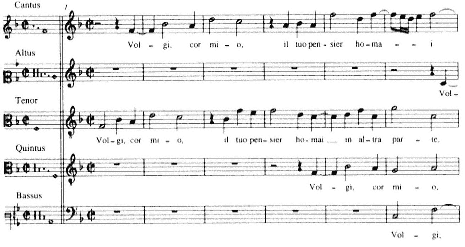
Ex. 41.
Parabosco, Volgi, cor mio, il tuo pensier homai (Fortunio Spira),
mm. 1-6; Madrigali a 5 (Venice, 1546), no. 7.
dissonance that Petrarch's poem achieves through consonantal clusters. The pompous energy of his syncopations captures rhythmically the spirit of the "cold will." By declaiming the word wholly in minims and thus misaccenting both syllables, Parabosco turned his back on Willaert's text-generated diction, giving up Willaert's semantic emphasis as well as the means to a stagier rhetorical climax.
Willaert's submission of all dimensions of his Musica nova madrigals to the rigors of a rhetorically determined declamation resulted in a speechlike musical oratory that his pupils generally pursued less adamantly than they did endearing local moments. The difference is evident even in Parabosco's sonnet settings, many of which (like Aspro cor ) are less weighty than one might expect. We should recall in this regard that in midcentury Venice a preoccupation with Petrarch did not necessarily signal elitism or even imply de facto a preference for sonnets. Petrarch after all was the most widely disseminated poet in the marketplace of printed editions and commentaries, and the sonnet by far the most common genre of the mid-sixteenth century (as abundantly evident in the copious anthologies of the time). Not all of the modern sonnets Parabosco set were especially introspective, nor were his settings of them. Mozzarello's O desir di questi occhi, for one, is an untroubled series of apostrophes to the beloved ending with a vaguely erotic "Deh, sarà mai ch'io vi riveggia et oda?" (Ah, will I ever see and hear you again?) that Parabosco set lightly in a compact ninety-four breves.[24] Similarly, his cheerful fifth-mode setting of Spira's Volgi, cor mio, il tuo pensier homai depicts a spurned poet who makes a pact with his heart over a disdainful lady; for this Parabosco opened with a cantus-tenor duet in quixotic fourths and graceful syncopations (Ex. 41).
[24] See the ed. in Bussi, Composizioni, pp. 38-50. It is not the only setting so brief; Parabosco's setting of Petrarch's Gli occhi di ch'io parlai is only eighty breves long.
Poems like these did not invite the expansively weighty style Parabosco used to set sonnets like Aspro core, Solo e pensoso, or I' vo piangendo.[25] Still further from these Petrarch sonnets — indeed at the opposite end of the spectrum — are settings like that of Martelli's madrigal Ultimi miei sospiri.
Ultimi miei sospiri, My last breaths,
Che mi lasciate fred'e senza vita, Which leave me cold and lifeless,
Contate i miei martiri Recount my sufferings
A chi morir mi vede e non m'aita. To one who sees me and does not help me.
Dite, o beltà infinita, Speak, oh infinite beauty, 5
Dal tuo fidel ne caccia empio So that your faithful one may drive out bitter
martire; suffering;
Et se questo l'è grato, And should this please her,
Gitene ratto in ciel', a miglior stato. Go swiftly to Heaven, to a better state.
Ma se pietà gli porg'il vostro dire, But if your speech arouses pity in her,
Tornat'a me, ch'io non vorrò morire. Return to me, for I do not wish to die. 10
Since settenari appear equally with endecasillabi here, Parabosco turned out shorter melodies than he did for sonnets (see Ex. 42). Many of the phrases span a single settenario in the manner of earlier Italian secular music — an approach also evident in his canzone settings like the stanza from Petrarch's Amor, se vuoi ch'io torni. Unlike the motetlike expositions of Venetians' sonnet settings, Ultimi miei sospiri moves in fast surface rhythms right from the opening, with entrances driving at a buoyant minim rate instead of the standard semibreve. The playful rhythmic assonance of the exposition — accented "miei" against "-mi" and "spi-" against "so-," piling strong / weak accents amid waves of syncopations — sets the tone for the rest of the madrigal. Parabosco accentuates it with fragmentary divisions of the verse, breaking off "sospiri" from "ultimi miei" with the little gasp that precedes so many sixteenth-century sighs (and even a repetition of "ultimi miei" in the tenor part). Some of the strategies he uses resemble those of contemporaneous black-note madrigals, with their widely divergent note values. Note, for example, how sharply "Gitene ratto in ciel" (v. 8), spit out in groups of semiminims (mm. 44-52), contrasts with the calm apostrophe following the double bar, "Dite, o beltà infinita" (mm. 37ff.).[26]
[25] In his setting of the two quatrains from I' vo piangendo Parabosco's extreme extension of the Venetian madrigal's new ideal of breadth seems almost like an exercise in one-upsmanship. By increasing dramatically the proportion of notes to words he virtually "used up" what he must have considered the allowable space for each parte, leaving no room for the sestet after 104 breves. A little arithmetic helps to clarify the point: had Parabosco set the complete sonnet with the same number of breves per verse as in the octave (on average thirteen), the entire madrigal would have expanded to 182 breves — an unheard-of size for a sonnet setting of the time. Rather than setting the sestet he merged two currently viable alternatives, the prototype of the extended sonnet setting developed by the Venetians and that of the truncated octave setting common in lighter madrigal repertories of the time.
[26] "Volti subitamente," from v. 5 of the sestina Mia benigna fortuna (also included in the Madrigali a 5 ), is set similarly to "Gitene ratto in ciel."
Parabosco's use of tritus modes for setting poems like Ultimi miei sospiri and Volgi, cor mio — modes generally described by modal theorists as more joyful than deuterus or protus plagal — raises the question whether Parabosco tried to fulfill criteria of modal affect or modal structure. We have already seen that neither Willaert's settings, nor even those of Rore's modally ordered First Book, reveal clear links between mode and affect apart from some intriguing cases of Phrygian. Yet Parabosco's book, despite its unorthodox organization, presents some suggestive evidence to the contrary. The tritus works in F mollis all set facile poems, save perhaps the sonnet of Castiglione. The protus group, on the other hand, seems to divide affectively according to the traditional bifurcation of ambitus: the two poems by Parabosco may have been meant to represent first mode, the dark
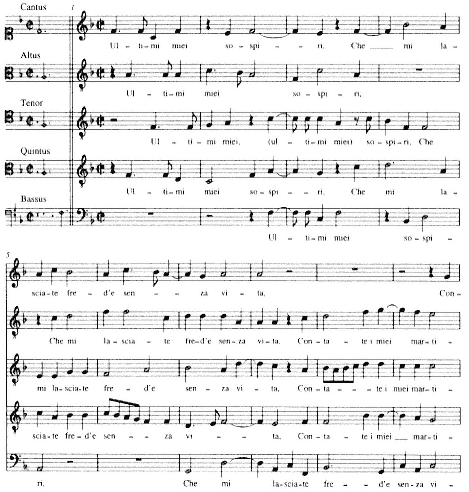
Ex. 42.
Parabosco, Ultimi miei sospiri (Lodovico Martelli), incl.; Madrigali a 5
(Venice, 1546), no. 6.
(continued on next page)
(continued from previous page)
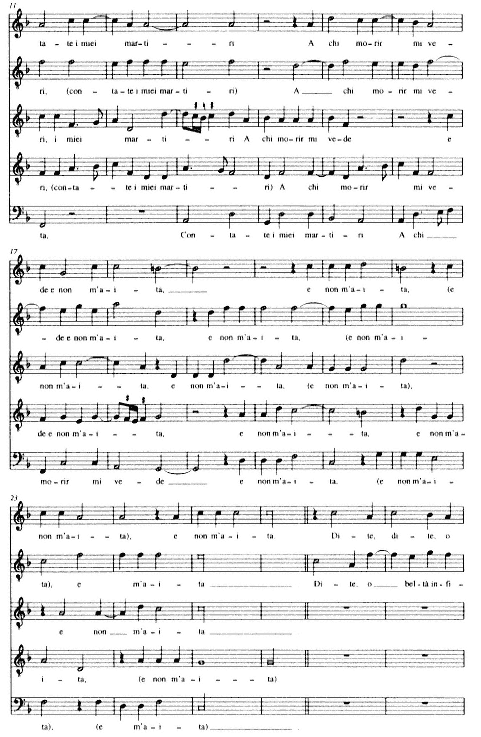
Ex. 4.2
(continued)
(continued on next page)
(continued from previous page)
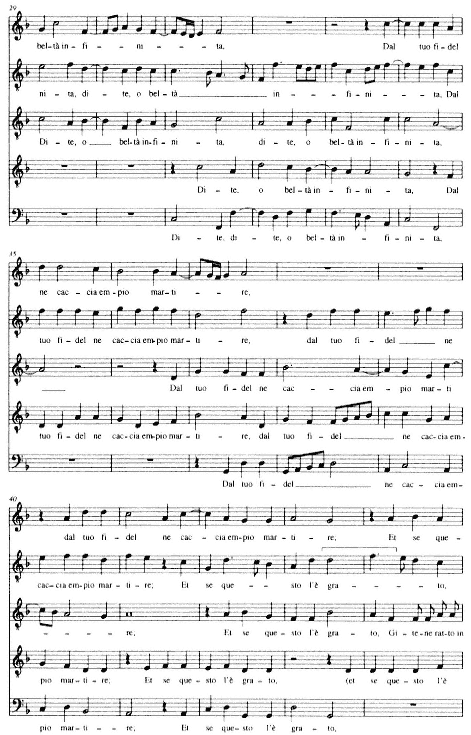
Ex. 4.2
(continued)
(continued on next page)
(continued from previous page)
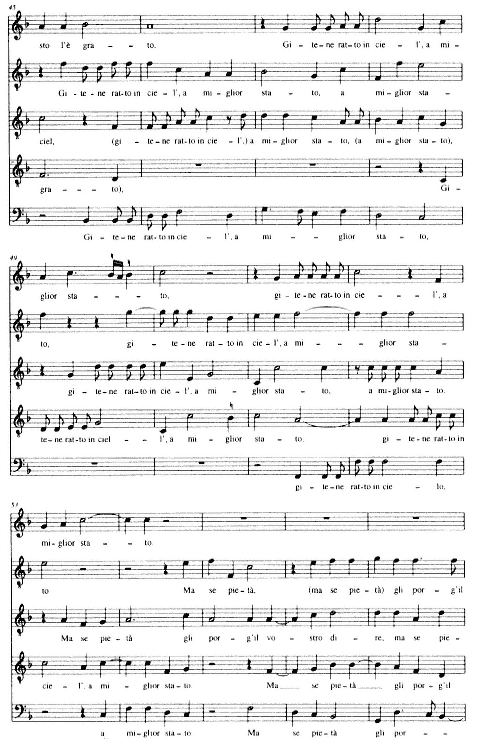
Ex. 4.2
(continued)
(continued on next page)
(continued from previous page)

Ex. 4.2
(continued)
Petrarchan sonnets Aspro cor and Solo e pensoso second mode. Most strikingly, all of the settings in the deuterus (Phrygian) category come from the "in morte" portion of Petrarch's Canzoniere — even the first four lines of the adapted Anima bella.
All of this jibes well with other knowledge of Parabosco. His debt to Rore's modally ordered Primo libro is clear at least in the case of Cantai mentre ch'io arsi and his book was dedicated to Rore's early patron Ruberto Strozzi. If modal issues occupied a place in the dialogues of Venetian salons, Parabosco would have been at the center of them, for he was as close to academic life there as any composer in the city.
Perissone Cambio: Madrigals for Five Voices
FORESTIERO: And who have you got here in the way of noteworthy men?
VENETIAN: Starting with musicians, we have Messer Adrian Willaert, who is chapel-master at San Marco, and you know what his fame is.
FORESTIERO: I've heard him called the Prince of Musicians.
VENETIAN: We also have Perissone, a soprano without equal who's been sought out by many princes but wouldn't exchange Venice for any other city.
FORESTIERO: It seems to me he's wise.[27]
Perissone Cambio was Willaert's most prolific disciple in the mid- to late 1540s. In addition to a book of canzoni villanesche alla napolitana dated 1545 he published three independent collections of madrigals, the two five-voice books of 1545 and 1550 and a four-voice book of 1547. All but the last were produced before Perissone even joined the roster at San Marco. Owing to a lack of positions or funds he entered the chapel only on 19 July 1548, before a real post had come available, and then, remarkably, on an unsalaried basis. Perissone owed his position to an unprecedented personal manoeuvre by doge Francesco Donà, who was effective in Perissone's being awarded the next valid opening seven months later, on 8 February 1549.[28] By that time Perissone may have developed connections with Rore as well as with Willaert, for Scotto's edition of Rore's Third Book of madrigals of 1548 (RISM 15489 ) had included one of Perissone's works (as Rore's second book had done four years earlier) and Perissone's Primo libro a quatro voci offered first printings of three
[27] For: E chi ci havete di huomini segnalati?
Ven. Cominciando dà Musici, noi ci habbiamo M. Adriano Vuigliaret, ilquale è Maestro di Capella di S. Marco, e voi sapete quale è la sua fama.
For. Lo ho sentito chiamar Principe de Musici.
Ven. Habbiamo similmente Perissone per Sorano senza alcun paro, ilquale desiderato da molti Principi, ma però non cambiarebbe Venetia per altra Città.
For. Mi par che sia savio.
From Francesco Sansovino, Delle cose notabili che sono in Venetia. Libri due, ne quali ampiamente, e con ogni verità si contengono (Venice, 1565) fol. 33; ded. 17 Sept. 1561. Il Venetiano goes on to name the other great musicians of that time: "il Salo Basso, il Zeffiro, il Franzese, Marc'Antonio, M. Angelo, Don Galeazzo da Pesaro, gentiliss. Spirito, Silvestro da Fontego, i Fauretti, Matteo dalla Viola, il Tromboncino, Annibale Organista, Claudio, Frate Armonio, e molti altri tutti eccellenti" (fols. 33-33').
[28] Ongaro, "The Chapel of St. Mark's," pp. 127-28.
of Rore's madrigals. In addition, the printer Gardane appears to have exploited Perissone's connections with Rore by having him write the dedication to Gardane's edition of Rore's Third Book (RISM 154810 ).
Francesco Donà numbered among several powerful Venetians who took an interest in Perissone's talents — a factor that was instrumental in building up his reputation as a singer and composer during the mid-forties. As we saw in Chapters 3 and 4, Perissone profited from the patronage of Gottardo Occagna, Antonio Zantani, and (most likely) Domenico Venier, and we can imagine him among the impressive performers Doni witnessed in Neri Capponi's salon too. Perissone was probably one of the showiest singers in the salons, a performer who repeatedly won plaudits in print for his singing, and, moreover, a singer of treble parts.[29]
Nothing precise is known of Perissone's origins or of the route that took him to Venice — only that he was Flemish, according to a privilege granted to him by the Senate.[30] By 1544 Perissone's five-voice setting of the anonymous sonnet Che cosa al mondo far potea natura appeared in Rore's Secondo libro and a four-voice setting of Vivo sol di speranza, rimembrando (the sestet of Aspro core ) in Arcadelt's Quinto libro.[31] He made his first major appearance that same year in Doni's Dialogo della musica, where he was designated an interlocutor along with Parabosco, Veggio, and others.[32] Doni's text already places him within a group that pictures itself on the cutting edge of Venetian musical developments. After those assembled sing his setting of Bartolomeo Gottifredi's Deh, perchè com'è il vostro al nome mio, one of the interlocutors praises Perissone as an "accomplished young man and commendable person" with a "beautiful voice" and fine compositional technique.[33]Deh, perchè is one of two madrigals of Perissone's in the Dialogo' s Venetian second half, the other a six-voice setting of Giunto m'ha Amor.[34]
In this early repertory Perissone was already cultivating both stylistic poles of a dichotomy that has been emerging gradually in our discussions of Venetian madrigals — the dichotomy between a songlike polyphony generated directly out of lyric form and meter and a more declamatory, motetlike polyphony shaped by
[29] Though the chapel rolls list Perissone as an alto, Francesco Sansovino's dialogue cited in n. 27 above suggests he must have taken the more difficult upper parts often enough to have been regarded popularly as a soprano, as Giulio Ongaro has argued ("The Chapel of St. Mark's," pp. 105 and 132). Ongaro notes that the term soprano was often used loosely, probably to designate anyone who sang the top line of a composition.
[30] See n. 38 below.
[31] The sestet had earlier been set by Arcadelt and published in his Terzo libro of 1539.
[32] See James Haar, "Notes on the Dialogo della musica of Antonfrancesco Doni," Music & Letters 47 (1966): 198-224, and Chap. 1 above, n. 56.
[33] The praise is initiated by the Piacentine Count Ottavio Landi: "Oh che belle parole, oh che bel canto! Perison certamente ha preso un modo dolce, fugato, chiaro e bellissimo." To this the female interlocutor Selvaggia responds, "Valente giovane e persona virtuosa non poteva far se non divinamente." Depicted here, like the other males in the dialogue, as an amorous courtier, Perissone responds by swearing fealty to Selvaggia (Dialogo della musica, p. 121).
[34] Ibid., pp. 114-20 and pp. 232-42, respectively; in Malipiero's ed. Giunto m'ha Amor is wrongly attributed to Willaert. It reappeared in 1546 in Madrigali di Verdelot et de altri autori a sei voci novamente con alcuni madrigali novi ristampati & corretti [RISM 154619].
rhetorical qualities and proselike diction. Deh, perchè and Giunto m'ha Amor mark the crystallization of this dichotomy. Gottifredi's poem concretizes the internalist poetics of Petrarch in playful, realistic, and sweetly erotic conceits, here encapsulated in the poet's plea that the beloved match his desire as her name does his.
Deh, perchè com'è il vostro al nome mio Oh why, since your name
Parimente conforme Conforms to mine
A mia voglia non è vostro desio? Does not your desire to my longing?
Scaldat', oimè scaldate, Warm, oh warm,
Donna gentil, nel mio amoroso ardore Gentle lady, your frozen desires 5
Vostre voglie gelate, In my loving ardor,
Che se qual esce fuore For if, just as the same sound
De i nomi un suono stesso Issues forth from our names,
Fosse par il voler nei cori impresso: The same desire were only impressed in our hearts,
O che bell'union d'animi santi, Oh what a lovely union of blessed souls, 10
O fortunati amanti! Oh fortunate lovers!
Perissone's setting of Deh, perchè has nothing of the pious Willaertian sobriety and complexity Perissone aspired to (however partially) in sonnet settings. Instead it indulged in sweet cascading melody and light, airy counterpoint to create a clear formal exposition, notable in the way the cantus's opening bars lay out Gottifredi's first period (Ex. 43). Perissone's exordial cantus traces the poetic exposition (vv. 1-3) in a series of ascents that rise by successive steps, peaking on the confinal dd, dropping to a caesura on aa (and "mio"), then reascending for a more ecstatic reiteration of dd ("conform'a mia voglia non è") before the syncopated stepwise descent ("vostro desio"). His writing displays the skill of a great arioso melodist, with the cantus unbroken from start to finish, suspending a large melodic arc between two tonal axes. Unlike the recitational melodies and equal-voiced polyphony of Willaert's and Rore's madrigals, here poetic affect is projected mainly through melodious adornment of the text. With the G-mollis tonality, chiavette cleffing, and delicate coloration, Perissone fashions an engaging chiaroscuro in polyphonic accompaniment to the lyrical cantus. The profusion of cross relations that result (C/C-sharp, F/F-sharp, E/E-flat, and B/B-flat) were ones he continued to exploit in later madrigals.[35] In this lyric and coloristic ebullience, some of the words go breezily misaccented ("pa-ri -men-te ") and in a way that resists the rigors of Willaert's sternly Bembist approach.
If the melodic style of Deh, perchè is pretty and tuneful, the six-voice setting of Giunto m'ha Amor shows that Perissone already knew something of the more severe idiom Willaert reserved for Petrarch's sonnets. Giunto m'ha Amor adheres closely to
[35] On the matter of cross (or false) relations see James Haar, "False Relations and Chromaticism in Sixteenth-Century Music," JAMS 30 (1977): 391-418.

Ex. 43.
Perissone, Deh, perchè com'è il vostro al nome mio (Bartolomco Gottifredi),
cantus, mm. 1-13; Madrigali a 5 (Venice, 1545), no. 1.
the even pulse of Willaert's setting with only occasional syncopations. At the same time it exploits harmonic coloration almost as much as Deh, perchè. A single example may be seen in the sonorities at "Che m'ancidono a torto" (Ex. 44), where Perissone alternately strengthened the fifth motion of the bass from D to B-flat (mm. 14-17) or colored the text through the addition of accidentals.
Reminiscent of Parabosco's 1544 settings, Perissone's Giunto m'ha Amor set only lines 1 through 8. By the time his first collection, Madrigali a cinque voci, was published in 1545, however, Perissone had begun to treat texts more as literary artifacts. Much like Rore's First Book, the Madrigali a 5 published twelve sonnet settings, all unabridged,[36] along with a few lighter settings including Deh, perchè at the head. This is the same mix seen in all the Venetian collections assembled principally for commercial markets, but the bibliographical history of Perissone's book explains more than most about the social context that helped generate it.
The Madrigali a 5 is an unsigned print. According to Jane Bernstein, it was probably produced in the publishing house of Girolamo Scotto — head of a consortium of printers — and most likely printed by Ottaviano Scotto.[37] The venture was engineered by Perissone himself, as made clear enough from the survival of a privilege he applied for from the Venetian Senate in order to print it.[38] As his first publication, the Madrigali a 5 thus represents Perissone's effort to make his name in Venice with a collection devoted exclusively to his own works (as I argued in Chapter 3). These circumstances are corroborated by its long and highly suggestive title page, which implies that the madrigals the book contains originated from a social setting much like the one depicted by Doni.
[36] For my ed. of the book see Sixteenth-Century Madrigal, vol. 2 (New York, 1990).
[37] "The Burning Salamander: Assigning a Printer to Some Sixteenth-Century Music Prints," Music Library Association Notes 42 (1985-86): 483-501, esp. pp. 493 and 497.
[38] Perissone applied for the privilege in June 1545, granted with the description "La musica per lui composta de madrigali sopra li sonnetti del Petrarcha"; see Einstein, The Italian Madrigal 1:439, and Richard J. Agee, "The Privilege and Venetian Music Printing in the Sixteenth Century" (Ph.D. diss., Princeton University, 1982), pp. 95-96 and 179.
It might be of interest that the print has a fairly high number of errors; see the notes that accompany my ed. cited in n. 36 above.

Ex. 44.
Perissone, Giunto m'ha Amor fra belle e crude braccia (Petrarch, no. 164),
mm. 12-19; in Antonfrancesco Doni, Dialogo della musica (Venice, 1544),
fol. 38 in cantus.
Madrigals for five voices by the excellent musician Messer Perissone Cambio, composed for the pleasure of various friends of his and now brought to light at the request of the same, and corrected, revised, and arranged by the composer himself. Never before seen or printed. Five voices. Venice, 1545. With grace and privilege.
Notwithstanding the claim that none of the madrigals had been previously printed, the book does signal Perissone's first major step into the public eye and his first efforts as an entrepreneur. His avowal in the dedication to Occagna that he himself is "having a few of [his] . . . madrigals for five voices printed" tends to confirm this.[39]
To the Noble and Valorous Signor Gottardo Ochagna
My most honorable lord, your virtue, kindness, and courtesy, having obligated me as much as anyone else who considers and experiences them, I cannot but always wish to find a way whereby I might somehow show you some sign of the love that I bear to you, thanks to your divine qualities. Therefore, my lord, knowing that, among the many other such rare virtues in which my lordship delights, Music is one that pleases you exceedingly, I did not want to lose this opportunity. So, since I am having a few of my madrigals for five voices printed — however they may be — I make a gift of them to your lordship in order to give you a small sign of the great desire I have to serve you. Might you then deign to accept with your usual kindness my humble present, keeping ever in mind the affection in my heart. Your perpetual servant, Perissone Cambio
In turning for backing to an afficionado of vernacular letters as well as music, Perissone made visible the symbiotic threads of his inaugural book: its self-promotional origins, its involvement in the new Venetian vogue for setting Petrarch's sonnets, and its appeal to consciously styled literary tastes in the vernacular. Not all the madrigals in it are settings of Petrarch's sonnets (as the privilege implied), but sonnet settings do occupy nearly three-quarters of the book and over half of these are Petrarch's (see Table 10). The others include some novel literary choices: one by Petrarch's early fifteenth-century Florentine imitator, Buonaccorso da Montemagno (no. 8), one by the Neapolitan poet of the early sixteenth century Jacopo Sannazaro (no. 15), and one of mixed attribution, probably by the eminent sixteenth-century Petrarchan Vittoria Colonna (no. 11).[40] All of the sonnet settings, moreover, are complete — still a new practice in the mid-forties, the only real precedent (among printed works) for which was Rore's First Book.
[39] See Chap. 3 above, nn. 13-14, and for the original title page and dedication Plates 9 and 10.
[40] With the exception of Buonaccorso and Colonna, the identifications I make here are found in Il nuovo Vogel 1:304-5. In addition to the poetic source given in Table 10, Buonaccorso's sonnet is reprinted in Poesia del quattrocento e del cinquecento, ed. Carlo Muscetta and Daniele Ponchiroli, Parnaso italiano, no. 4 (Turin, 1959), p. 13. The text of no. 2 is attributed to Colonna in Rime diverse, di molti ecc. autori . . . libro primo, 2d ed. (Venice, 1546), p. 293, but Vogel names its author as Cottemanno, probably on the basis of its inclusion in Philippe de Monte's collection devoted to Cottemano's spiritual poems, Primo libro de' madrigali spirituali a cinque voci (Venice, 1581). The earlier attribution to Colonna seems more likely. The other sonnet settings, nos. 4 and 6, remain anonymous.
| ||||||||||||||||||||||||||||||||||||||||||||||||||||||||||||||||||||||||||||||||||||
(table continued on next page)
(table continued from previous page)
| ||||||||||||||||||||||||||||||||||||||||||||||||
Indeed, Perissone could well have gotten various ideas for his own collection from Rore's, including the idea of ordering the corpus by mode, with high-clef arrangements (chiavette) standing in for authentic modes, lower clefs for plagals. Rore's Primo libro may also have helped inspire Perissone's inclusion of several black-note madrigals using common time signatures (C), copious syncopation, and a wide range of rhythmic values (nos. 6, 9, 12, and 14).
Unlike Rore's, however, all of Perissone's sonnet settings divide (like Willaert's) after the octave, and none of them actually resets sonnets set by Rore. Instead, three of the six Petrarch sonnets (nos. 3, 12, and 16) were among those later published in the Musica nova, making the Madrigali a 5 the first in the stream of books to imitate directly Willaert's madrigalian practice. Two of these, Cantai, hor piango and I piansi, hor canto, respond frankly to an implicit compositional challenge. In Cantai, hor piango Perissone adopted a characteristic imitative procedure from Willaert's exposition, compressed it, and simplified it thematically. (See the beginning of Willaert's setting in Ex. 45a and Perissone's imitation in Ex. 45b.) Following his model, Perissone introduced the downward- and upward-moving versions of the opening motive a semibreve apart but varied the whole texture less than Willaert had. He discarded the simple breve/semibreve motive that Willaert had assigned
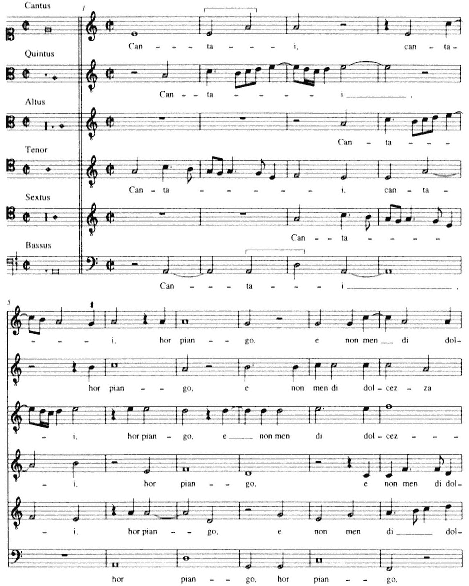
Ex. 45A.
Willaert, Cantai, hor piango, e non men di dolcezza (Petrarch, no. 229),
mm. 1-27; Musica nova (Venice, 1559), no. 17.
(continued on next page)
(continued from previous page)
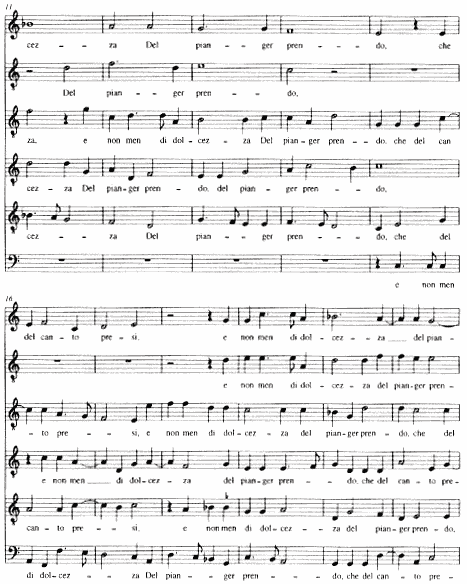
Ex. 45A
(continued)
(continued on next page)
(continued from previous page)
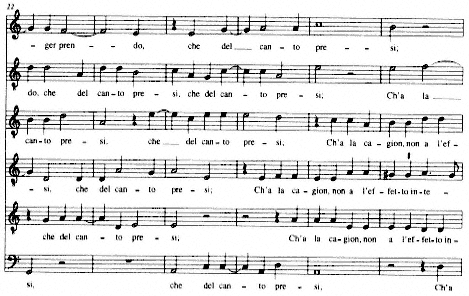
Ex. 45B.
Perissone, Cantai, hor piango, e non men di dolcezza (Petrarch, no. 229),
mm. 15-18; Madrigali a 5 (Venice, 1545), no. 3.
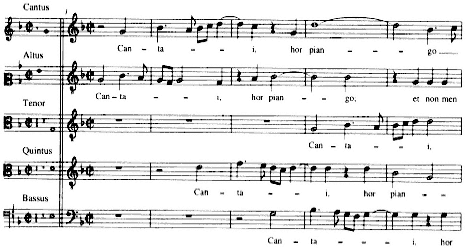
(continued on next page)
(continued from previous page)
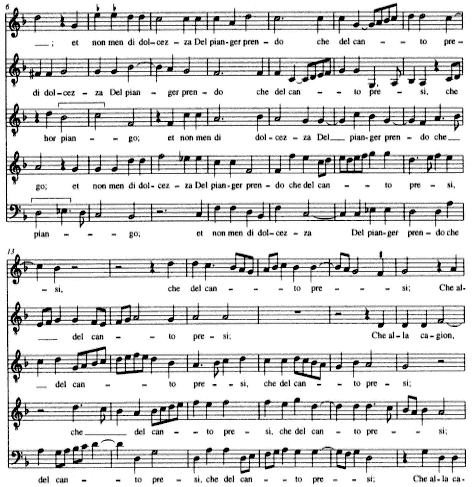
Ex. 45B
(continued)
to "cantai" in the outer parts and in place of Willaert's double-subject counterpoint created a simpler single-subject point of imitation with every voice stating the lone motive either in its original form or in inversion.
Perissone's opening also lacks the chiming multivoiced effect that Willaert achieved by exploiting closely staggered inner parts. In Willaert's setting each of these parts enters on the same note, a, the parts paired symmetrically with quintus inverting tenor, then altus inverting sextus. The contrapuntal and motivic intricacies spread over twelve breves and more before v. I is played out by all voices, as compared with seven in Perissone's setting. Perissone's smaller exposition is characteristic of his generally shorter-winded approach and the smaller proportions of his work as a whole in comparison with Willaert's (53 and 57 measures, as compared with 70 and 69 in Willaert's): the different sizes result from dissimilar ways of handling poetic and musical materials. Willaert's varied parsings often explore a variety
of syntactic divisions and groupings for a single excerpt of text, while Perissone reads more uniformly to produce terser settings overall.
Note, for instance, the array of alternatives Willaert searched out in parsing the first two verses of Cantai, hor piango:[41]
1. Cantus: Cantai / cantai / hor piango / e non men di dolcezza Del pianger prendo / che del canto presi / e non men di dolcezza del pianger prendo / che del canto presi
2. Quintus: Cantai / hor piango / e non men di dolcezza / Del pianger prendo / e non men di dolcezza del pianger prendo che del canto presi / che del canto presi
3. Altus: Cantai / hor piango / e non men di dolcezza / e non men di dolcezza Del pianger prendo che del canto presi / e non men di dolcezza del pianger prendo che del canto presi / che del canto presi
4. Tenor: Cantai / cantai / hor piango / e non men di dolcezza Del pianger prendo / e non men di dolcezza del pianger prendo che del canto presi che del canto presi
5. Sextus: Cantai / hor piango / e non men di dolcezza Del pianger prendo che del canto presi / e non men di dolcezza del pianger prendo che del canto presi
6. Bassus: Cantai / hor piango hor piango / e non men di dolcezza Del pianger prendo che del canto presi / che del canto presi
Each voice presents a different reading, stringing together various syntactic fragments freely and irregularly in a way that elevates variable syntax to the status of a musico-rhetorical ideal. By reading the same text identically in every part, Perissone's practice accords with many of Parabosco's text settings (the only exception is a repetition of "che del canto presi" by the quintus): "Cantai / hor piango / e non men di dolcezza Del pianger prendo che del canto presi / che del canto presi." Not surprisingly, Willaert required nine breves more than Perissone to set the same two lines in a manner that is weightier, broader, more complex and convoluted, but also less lucid and immediately winning than his student's.
Perissone must have taken Willaert's lead in building much of Cantai on harmonic motion by fifth, especially at the opening of the seconda parte. Willaert set the bass moving in circles of fifths a total of three times for the poet's proclamation "Tengan dunque ver me l'usato stile / Amor, Madonna, il mondo et mia fortuna" (Let them keep toward me their accustomed style, Love, my lady, the world, and my fortune): from an E-major triad to one on C-major; from E to C
[41] These verses are not ambiguous in the way of v. 8 from Pien d'un vago pensier, however; see Chap. 7, pp. 246-49.
again at double the harmonic rhythm; and from A to F. Perissone began his seconda parte with fifth motion as well, initially from G to B-flat and (a little later) from A to C and D to F. The progressions and their particular locations differ, but the coloring and sense of drive are similar,[42] Perissone adopting Willaert's fifth motion to reinitiate the syntactic process after the octave break and propel the paratactic series forward at v. 10, "Amor, Madonna, il mondo et mia fortuna." Here it is worth recalling Einstein's observation that even in such polyphonic surroundings, this sort of writing can produce textures in which "the bass takes no part in the motivic structure but functions merely as a support," the four parts above it forming a sort of "concertante."[43]
In sum, Perissone's borrowings in Cantai, hor piango avoid literalism in favor of a free gloss. Comparison of these borrowings with those of Cantai's companion sonnet I piansi, hor canto shows that Perissone's tendency to compress and simplify was habitual. Here too Willaert's model provided a complex exposition in double counterpoint (Ex. 46a), the first subject a three-note stepwise descent that generates harmonic suspensions, the second a fifth-leap followed by a downward step. At first both subjects move solely in breves. The two upper voices give out the opening subject, with the comes introducing suspensions over the dux as well as over lower voices that enter later. The second motive first emerges in the bass as a harmonic support (m. 2), resolving the harmonies set askew by the cantus, and only later takes flight as a melodic motive in its own right. Perissone's exposition (Ex. 46b), like the one in Cantai, is again substantially shorter than Willaert's (the words "I piansi" lasting through four and a half measures as opposed to ten in Willaert's), and his setting is more effulgent. Perissone appropriated Willaert's G-durus tonality but used it at a higher cleffing, replacing c1 with g2 in the cantus. As in Cantai, he smoothed out irregularities in Willaert's version by giving the syntactic readings a simpler, more homogeneous character. Instead of two motives of equal status, he employed just one, similar to the second of Willaert's two. He treated it in a regularized imitation, with each of the five voices entering at equal temporal intervals of a semibreve and moving straight through the rest of the verse ("hor canto che 'l celeste lume") after a single statement of "I piansi."
Along with the simplification and abbreviation that mark Perissone's imitation goes a general lightening of tone. Perissone did away with the descending motive of Willaert's exposition and its pervasive suspensions. Having eliminated the drooping minor second on "piansi," he reduced the number of suspensions to just one (m. 3), working neither of them back into Willaert's second motive — the one he did borrow.
[42] For the scores see Willaert, Opera omnia 13:73-79, and Perissone, Madrigali a cinque voci, ed. Feldman, Sixteenth-Century Madrigal 2:24-40. There are a number of examples of this among Willaert's settings of sestets, e.g., Mentre che 'l cor dagli amorosi vermi, in Willaert, Opera omnia, ed. Hermann Zenck et al., Corpus mensurabilis musicae, no. 3, AIM ([Rome], 1950-), 13:32-36 (on which see Feldman, "Rore's 'selva selvaggia': The Primo libro of 1542," JAMS 42 [1989]: 558-60).
[43] The Italian Madrigal 1:440.
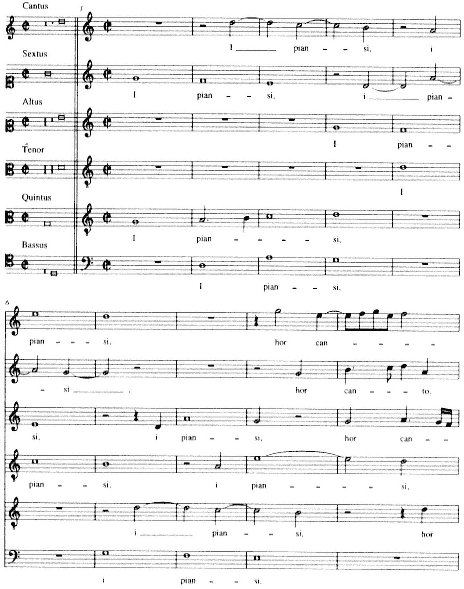
Ex. 46A.
Willaert, I piansi, hor canto, che 'l celeste lume (Petrarch, no. 230),
mm. 1-10; Musica nova (Venice, 1559), no. 16.
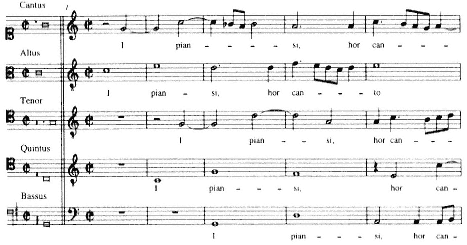
Ex. 46B.
Perissone, I piansi, hor canto che 'l celeste lume (Petrarch, no. 230),
mm. 1-5; Madrigali a 5 (Venice, 1545), no. 16.
In the face of these modifications toward more appealing — and no doubt more public — prototypes, we should not underestimate Perissone's participation in the musical practices of Petrarchism that his teacher epitomized. Two further passages from I piansi help make the point. First, Perissone's I piansi follows Willaert's model in drawing the exposition of v. 5, "Onde suol trar di lagrime tal fiume" (Thus he [Love] is wont to draw from me such a river of tears), over eleven breves. Also, like Willaert, he introduced plaintive B-flat's at "lagrime" and later "pianger" (v. 10) to produce minor seconds and thirds — a gesture that had by then become conventional. Second, at the beginning of the final tercet, "Non lauro o palma, ma tranquilla oliva / Pietà mi manda" (Pity sends me not a laurel or a palm, but the tranquil olive), Perissone emulated Willaert's slowing of the composite rhythm to the semibreve. This type of surface deceleration almost always marks moments of key rhetorical importance in Willaert's writing — a point of symbolic significance, a shift of grammatical person or tense, or an important twist in meaning — especially in articulating structural divides. In the Petrarchan lexicon the words signify the crucial mirror relationship laurel-Laura, of course. Like Willaert, Perissone applied the device a second time at the image of pity drying the poet's tears, "E 'l pianto asciuga" (v. 14),[44] a brief reminder of the opening and one that helps bring the poem full circle.
Perissone's second book a 5 (and his last book of madrigals) continued to extend directions taken up in the Madrigali a 5. Published by Antonio Gardane in 1550, it
[44] In Willaert, mm. 116-18, and Perissone, mm. 111-12.
was given the title Il segondo libro di madregali a cinque voci con tre dialoghi a otto voci & uno a sette voci novamente da lui composti & dati in luce and affixed with a brief dedication to Domenego Roncalli.[45]
To the noble and gentle young man, Mr. Domenego Roncalli, my most eminent lord.
If your lordship will consider well your valor and kindness, you will surely believe without further ado that I have remained such a servant to you from the first day that I came to know you here in Venice; for an ardent desire was born in me to serve and honor you always. I dedicate to you, then, with all my powers, these madrigals of mine, which you might deign to accept not as a gift matched to your worth, but rather as a little sign of the great affection of my reverence, and I kiss your hands with all humility. From Venice on the 3rd of May. Loving servant, Pierisson Cambio.[46]
Domenego Roncalli is not a name that otherwise appears in connection with Venetian music. He may be the same as Giovanni Domenico Roncalli, descendant of a noble Bergamese family that was added in 1545 to the Consiglio Communale of Rovigo, a Venetian outpost. According to his recent biographer, this Roncalli spent a good deal of time at both Padua, where he had a house, and Venice, where in 1554 the doge Francesco Venier made him a cavalier of San Marco.[47] Intriguingly, he gained notoriety in the Veneto by founding an academy in Rovigo in 1553, the Accademia degli Addormentati (later condemned for Calvinist heresies) that was styled after the cultural academies of Venice but with a public aspect that prefigures Badoer's Accademia Veneziana.
Whether this Roncalli is the same as Perissone's dedicatee and what relation he might bear to the print unfortunately remain mysteries. It would be gratifying to connect the two, not least because the Segondo libro counts as yet another Venetian print to attempt some kind of modal ordering, though the least straightforwardly of Perissone's three madrigal books (see Table 11). Like Parabosco's collection, its works are arranged in modal groups without obvious distinctions of ambitus, but unlike Parabosco's they are given in the usual ascending order, protus, deuterus,
[45] There is no mod. ed. of the book at present.
[46] Al Nobile & Gentile Giovane Il Signor Domenego Roncalli Signor mio Osservandissimo.
Se vostra signoria considerera bene il Valore & la gentilezza sua, ella senza piu credera bene ch'io le ristassi tanto servitore il primo giorno che qui in Vinegia la conobbi, che in me sia nasciuto ardente desiderio di sempre servirla, & honorarla. io le dedico adunque insieme con tutto il poter mio questi miei Madrigali: i quali ella si degnera d'acettare, non per presente conveniente al suo Valore: ma si bene per picciolo segno del grandissimo affetto della mia riverenza & a V.S. con ogni humilta bascio le mani. Di Vinegia alli 3 di Maggio. Amorevole Servitore Pierisson Cambio.
[47] See Stefania Malavasi, "Giovanni Domenico Roncalli e l'Accademia degli Addormentati di Rovigo," Archivio veneto, 5th ser., 95 (1972): 47-58, and Gino Benzoni, "Aspetti della cultura urbana nella società veneta del' 5-600: le accademie," Archivio veneto 108 (1977): 114-15. My information relies on Malavasi, to which I can add only that a Giocan da Roncali fu Giovanni Domenico da Rovigo, apparently Roncalli's son, made his will in Venice on 25 May 1596 (I-Vas, Archivio Notarile, Testamenti, Atti Beni, b. 160, fol. 239).
| ||||||||||||||||||||||||||||||||||||||||||||||||||||||||||||||||||||||||||||||||||||
(table continued on next page)
(table continued from previous page)
| ||||||||||||||||||||||||||||||||||||||||||||||||||||||||||||||||||||||||||||||||||||
tritus, and tetrardus, until the four dialogues at the end (nos. 20-23). Only the tritus-mode madrigals appear to distinguish unambiguously between authentics and plagals,








Ambiguities like these confirm that the book's "modal" arrangement was made ex post facto, either by Perissone, who had made or collaborated on the modal ordering of his first five-voice book, or by Gardane in collaboration with Perissone. If I am right that modal ordering and sonnet setting were companion projects among Venetians, then the book's poetic contents show a commitment to sonnet setting about equal to its commitment to modal thinking (both of which were less than Perissone's had been in putting together his Rore-like First Book). Ten of the Segondo libro's poems are Petrarch's, nine of them sonnets (three dialogues), and one a madrigal.[50] The book also contains two sonnets by Bembo and one possibly by Ariosto — poets represented by one poem each in Perissone's earlier two books. The only other poets identifiable at present are Luigi Cassola, author of the madrigal Alma gentil, s'in voi pietà fu mai, and Panfilo Sasso, the late-fifteenth-century Petrarchan poet whose dialogue "Quando nascesti, Amor? Quando la terra" was also included in Willaert's Musica nova. Eight poems remain anonymous.
In all, the Segondo libro contains a record seven settings of texts in the Musica nova.[51]
[48] "Tonal Types and Modal Categories," pp. 451-52.
[50] One of these, the sonnet Amor m'ha posto come segn'al strale, had already been published in 1548 in Scotto's edition of Rore's Terzo libro a 5, RISM 15489.
[51] One other poem was previously set by Willaert, the anonymous Amor, da che tu voi (see Chap. 7 n. 40).
1. I vid' in terra angelici costumi
2. In qual parte del ciel, in qual idea
3. Gionto m'ha Amor fra bell'e crude braccia
4. "Occhi piangete, accompagnate' il core"
5. "Liete e pensose, accompagnat'e sole"
6. "Che fai, alma? Che pensi? Havren mai pace?"
7. "Quando nascesti, Amor? Quando la terra"
Helga Meier noted borrowings from Willaert's settings in five of these madrigals (as well as connections between Perissone's five-voice setting of the anonymous Amor, da che tu voi pur ch'io m'arischi and Willaert's four-voice Amor, Fortuna, et la mia mente schiva ).[52] The Musica nova 's four dialogue sonnets make up four of the seven. They furnish yet another sign of how early the Musica nova had taken shape as a collection and represent through Perissone's placement of them at the end of his book a novel attempt to imitate something of the outer form of Willaert's collection.[53]
As in the Madrigali a 5, Perissone's Second Book's imitations showed a refined melodic flair and general brightening that resists Willaert's sternness. To cite a single example, he replaced the dark



Nonetheless, Perissone's In qual parte del ciel offers a kind of ideal exemplar of emulation practice. Helga Meier pointed out two unambiguous references to Willaert's original: the circle of fifths imitating Willaert's characteristic opening of the seconda parte and its accompanying motivic-contrapuntal structure (Exx. 49a and 49b); and Willaert's soggetto for v. 4, "Mostrar qua giù quanto lassù potea"
[52] The five related settings cited by Meier are: I vidi in terra, In qual parte del ciel, "Liete e pensose," "Che fai, alma?," and "Quando nascesti, Amor?" ("Zur Chronologie der Musica Nova, " p. 76).
[53] At least two other collections made a less sweeping attempt to do this: Donato's Primo libro d'i madregali a 5 & a 6 of 1553 (discussed below) and the Paduan Francesco Portinaro's Primo libro de madrigali a cinque voci of 1550, with five six-voice settings and a seven-voice setting of "Liete e pensose" at the end.
[54] Cf. the triple meter that starts the seconda parte of no. 11. For Qual dolcezza giamai see Willaert, Opera omnia 14:65-70, esp. mm. 64-69.
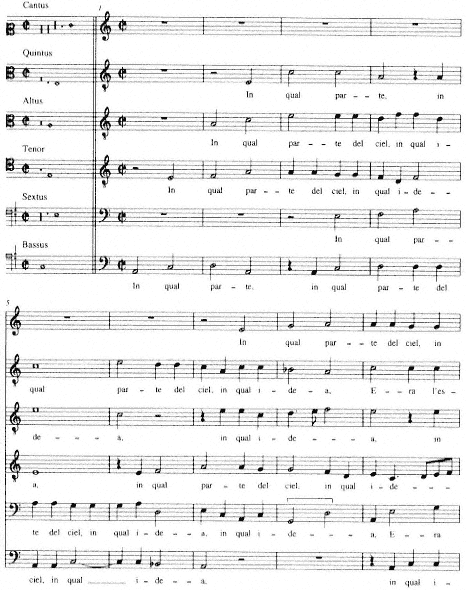
Ex. 47A.
Willaert, In qual parte del ciel, in qual idea (Petrarch, no. 159),
mm. 1-13; Musica nova (Venice, 1559), no. 18.

Ex. 47B.
Perissone, In qual parte del ciel, in qual idea (Petrarch, no. 159),
mm. 1-13; Segondo libro a 5 (Venice, 1550), no. 14.
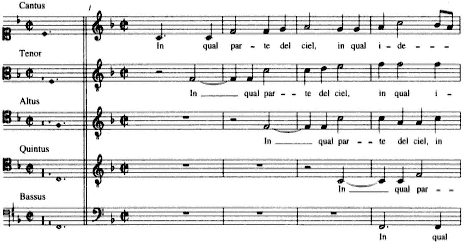
(table continued on next page)
(table continued from previous page)
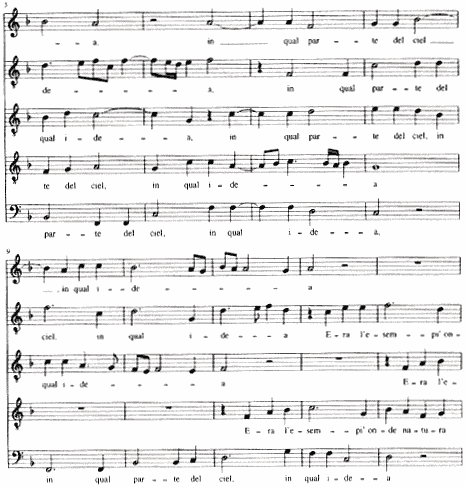
Ex. 47B
(continued)
(compare the altus of each in Exx. 50a and 50b). In fact Perissone adopted Willaert's declamatory gestures even more extensively than this, borrowing the rhythm of Willaert's homorhythmic altus-tenor duet at v. 3 and taking over the four-note figure for "Chiome d'oro" of v. 6. Even so, he continued to avoid the obscuring intricacies of a pervasively varied motivic structure. In both of the cases just cited he turned Willaert's soggetti into unvaried rhythmic figures (or nearly so); Willaert's setting continually alters the rhythms applied to v. 3 by shifting stressed syllables between tonic and agogic accents and also adds small melismas, while Perissone's
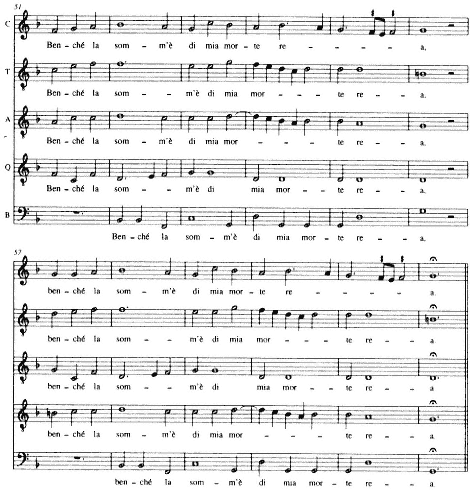
Ex. 48.
Perissone, In qual parte del ciel, in qual idea (Petrarch, no. 159),
mm. 51-62; Segondo libro a 5 (Venice, 1550), no. 14.
retains the same rhythmic morphology for each entry (Exx. 51a and 51b). Likewise, Willaert made "Chiome d'oro" rhythmically fluid and metrically elusive: four of the six voices start with the syncopated figure and two others on the tactus, nearly transforming the motive into anonymity. Here again Perissone repeated Willaert's rhythm exactly at each of the five entrances — yet never with the precise rhetorical incentive Willaert seems to have had in those rare instances when he avoided motivic variation (see Ex. 15 and Chap. 7 n. 47).
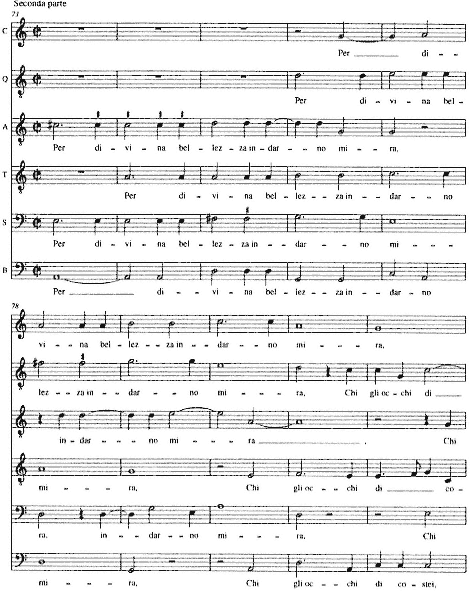
Ex. 49A.
Willaert, In qual parte del ciel, in qual idea (Petrarch, no. 159),
mm. 73-82; Musica nova (Venice, 1559), no. 18.
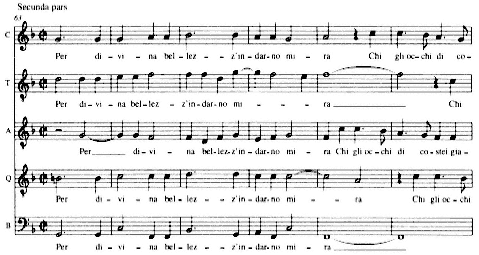
Ex. 49B.
Perissone, In qual parte del ciel, in qual idea (Petrarch, no. 159),
mm. 63-68; Segondo libro a 5 (Venice, 1550), no. 14.

Ex. 50A.
Willaert, In qual parte del ciel, in qual idea (Petrarch, no. 159),
altus, mm. 25-28; Musica nova (Venice, 1559), no. 18.

Ex. 50B.
Perissone, In qual parte del ciel, in qual idea (Petrarch, no. 159),
altus, mm. 29-33; Segondo libro a 5 (Venice, 1550), no. 14.
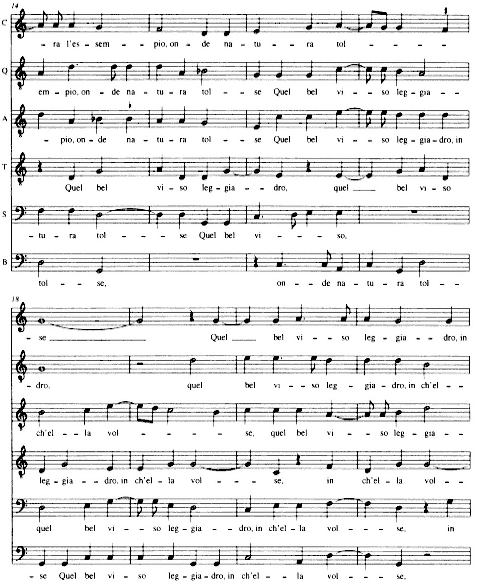
Ex. 51A.
Willaert, In qual parte del ciel, in qual idea (Petrarch, no. 159),
mm. 14-21; Musica nova (Venice, 1559), no. 18.
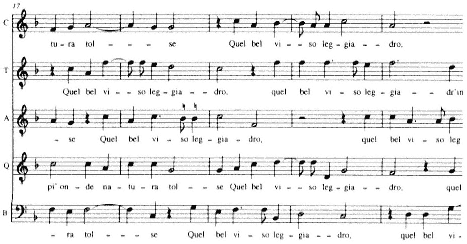
Ex. 51B.
Perissone, In qual parte del ciel, in qual idea (Petrarch, no. 159),
mm. 17-21; Segondo libro a 5 (Venice, 1550), no. 14.
Perissone Cambio: Madrigals for Four Voices
In 1547 Perissone published with Gardane his Primo libro di madrigali a quatro voci — as it turned out, the only four-voice madrigal book to be issued by any of Willaert's immediate students.[55] Like Perissone's other books, the Primo libro a 4 is arranged in ascending modal order — at least through no. 22, the end of the consecutive block of madrigals that are Perissone's own (see Table 12). The modal ordering extends to distinctions between authentics and plagals (unlike the Segondo libro a 5 ), albeit with a few anomalies.[56] Nothing else unites the book, however, and otherwise it is Perissone's most diverse, merging in a single collection the widely disparate generic traditions that attached to madrigals for four voices, on the one hand — chansonesque madrigals à la Verdelot and Arcadelt, madrigals for theater, madrigals a note nere, madrigals related to frottole, and songs in the oral tradition — and the
[55] I except the four-voice book of madrigals published by Nicola Vicentino of Vicenza (in the Veneto) in 1546 because it bears so little relation to the style that Willaert's Venetian circle was pursuing at the time; see Del unico Adrain Willaerth discipulo don Nicola Vicentino madrigali a cinque voci per theorica et pratica da lui composti al nuovo modo dal celeberrimo suo maestro ritrovato. Libro primo (Venice, 1546); mod. ed. Nicola Vicentino, Opera omnia, ed. Henry W. Kaufmann, Corpus mensurabilis musicae, no. 26, AIM ([Rome], 1963), pp. 1-60.
| ||||||||||||||||||||||||||||||||||||||||||||||||||||||||||||||||||||||||||||||||||||||||||
(table continued on next page)
(table continued from previous page)
| ||||||||||||||||||||||||||||||||||||||||||||||||||||||||||||||||||||||||||||||||||||||||||||||||
generally more monolithic, learned traditions of five- and six-voice madrigals, especially of sonnet settings, on the other.
Perissone's book included sonnets, ballate, cinquecento madrigals, and ottave rime. Not all of these had lately been linked to four -voice settings and certainly not mixed in a single volume. Of the twenty-six numbers, the largest share (predictably) are settings of cinquecento madrigals, eleven of them by Perissone (nos. 1, 2, 6, 8, 10, 15, 16, 18, 20, 22, and 26) and three by Cipriano de Rore (nos. 23, 24, and 25).[57] Rore's contributions include the first publication of his setting of Alfonso d'Avalos's Anchor che col partire, one of the most often reprinted and imitated secular settings of the century. Einstein may have overstated the case in calling it the model for the whole collection,[58] but it has suggestive stylistic parallels with Perissone's many madrigal settings in the book.
Sonnet settings, by comparison, total only five — all Petrarch's and all complete (nos. 3, 12, 14, 17, and 21). This makes Perissone's emphasis on madrigals over sonnets an apparent emphasis of Rore's four-voice model over the four-voice madrigals in the Musica nova . Yet it is Perissone's sonnet settings that are newest and that introduce the single most significant dichotomy in the collection. Perissone was the only one of Willaert's disciples to write four-voice settings of Petrarch's sonnets in a style close to the Musica nova. Four of them in fact set Musica nova texts: Io amai sempre & amo fort'ancora (the only one also for four voices in Willaert's setting), In qual parte del ciel, Più volte già dal bel sembiant'humano, and Pien d'un vago pensier. We might add to the book's weightier sonnet side its two ballata settings, no. 11, Come potrò fidarmi, Brevio's Cantai mentre ch'i arsi (earlier published in settings by Rore and Parabosco), as well as the anonymous Amor, da che tu voi (no. 22), set in two parts (like Willaert's setting of 154-8 and Perissone's of 1550).
None of the poems I have placed in this group is shorter than twelve lines long. By contrast, only one of the madrigal texts (apart from no. 22) is longer than nine lines (no. 8), including Rore's. These tiny poems generally concentrate on a single, concisely developed conceit. The slight literary status they claimed in musical prints may have been nil outside of music: except for those by Cassola (no. 15) and d'Avalos, all the madrigal texts are as yet anonymous.
To complete this sketch of the book's contents, the four remaining numbers are ottave rime. One of them is Bembo's (no. 5), another a stanza from Ariosto's Orlando furioso, 24.1 (no. 7), and the other two (nos. 4 and 19) again anonymous. Ottave rime are among the least common forms to appear in contemporary Venetian collections. With their lucid songlike textures and avoidance of contrapuntal artifice, they fall more on the madrigalian than the sonnet side of Venetian production. Their form — endecasillabi rhyming ABABABCC — was a long-standing
[57] Perissone's setting of the first seven lines from Petrarch's canzone Perchè la vit'è breve (no. 9) might just as well be added to this group, as it functions similarly to the madrigals, extracting the piedi and the first line of the sirima from the opening stanza.
[58] The Italian Madrigal 1:441.
vehicle of poet-improvisors in the oral tradition, the structural prototype shared by epic poetry and the lyric strambotto, as well as occasional stanzas. Thus their presence in the Primo libro a 4 may signal yet again the enduring connection between settings of ottave rime and traditions of improvisatory song.[59]
This brings us to the dedication attached to the collection, made to the renowned Paduan poet Gaspara Stampa who was famed for her singing to the lute.
To the lovely and talented Signora Gasparina Stampa
Noble lady, well might I be reproved by the wise and learned composers of this sweet and admirable science — reproved in this science, yes, but no man in the world will ever be able to say that I have had little judgment in dedicating these notes of mine to your ladyship, however they may be. Because it is well known by now — and not only in this fortunate city, but almost everywhere — that no woman in the world loves music as much as you do, nor possesses it to such a rare degree. And thousands upon thousands of fine and noble spirits attest to this who, having heard your sweet harmonies, have given you the name of divine siren, remaining over time your most devoted servants, among whom I am as devoted as any. I come with this my little token and gift to refresh the memory of the love that I bear for your talent, begging that you deign to find me worthy to be placed where you place the innumerable throngs of those who adore and love your rare talents and beauties. And to your graces I commend and offer myself. Most devoted servant Pieresson Cambio.[60]
In Chapter 4, I suggested that a connection might exist between the kind of solo and at least quasi-improvisatory singing for which Stampa was acclaimed and the treble-dominated writing and periodic phraseology that pervades much of Perissone's four-voice book. Even though his published settings were suited to part singing, it is reasonable to imagine alternatively that at least some of them could have been adapted for solo singing to lute accompaniment or simply been performed by a solo treble singer to the accompaniment of viols or broken consort on the lower parts. Perissone's plea to be placed among Stampa's adoring throngs
[59] On this matter and in connection with the discussion that follows see Chap.4 nn. 68-80 above, esp. the literature cited in n. 75. See also James Haar, "Arie per cantar stanze ariotesche," in L'Ariosto: la musica, i musicisti, ed. Maria Antonella Balsano (Florence, 1981), pp. 31-46, and idem, Essays on Italian Poetry and Music in the Renaissance, 1350-1600 (Berkeley and Los Angeles, 1986), pp. 92-99.
[60] Alla bella et virtuosa Signora Gasparina Stampa
Valorosa signora, io potrò ben esser ripreso apresso ai saggi, & dotti compositori di questa dolce et mirabile scienza: in essa scienza ma no mi potra gia huomo del mondo dire giamai ch'io habbia havuto poco giuditio nel dedicare queste mie note, quale elle siano, alla S.V. perche si sa bene homai. & non pure in questa felice citta: ma quasi in ogni parte, niuna donna al mondo amar piu la Musica di quello che fate voi, ne altra piu raramente possederla, & di questo ne fanno fede i mille, & mille spirti gentili, & nobili: i quali udito havendo i dolci concenti vostri, v'hanno dato nome di divino sirena, restandovi per tempo devotissimi servi, fra i quali, io devoto quanto altro, vengo con questo mio picciolo segno & presente, a rinfrescarle nella memoria, lo amore ch'io porto alle sue virtu, pregandola che si degni, ch'io sia degno di esser posto dove ella pone la innumerabil turba di quei ch'adorano, & amano le sue rare virtu, & bellezze. & alla sua bona gratia mi raccomando & offero. Devotissimo servo Pieresson Cambio.
might be glossed as a hope that his songs will grace her repertory. It might also have been a way of insinuating himself as fellow singer in the elect circles of literary academists with which Stampa surrounded herself in various private homes, including her own. To say so is to suggest that a four-voice book of the 1540s might still have functioned at times as a sort of fakebook — as books of frottole had done — providing raw material to be freely adapted according to variable needs. One of its specific functions may have been that of a solo songbook (also like books of frottole), thus continuing the alliance of early madrigals with solo song made so patent by Willaert's intabulations of Verdelot's madrigals a decade earlier.[61]
Vestiges of recitational practice from unwritten traditions are embedded in Perissone's setting of Ariosto's stanza Chi mett'il pie su l'amorosa pania from Orlando furioso, the central textual repository for sixteenth-century improvvisatori (Ex. 52).
Chi mett'il pie su l'amorosa pania May he who puts his foot in the loving birdlime
Cerchi ritrarlo e non inveschi l'ale, Try to extract it and not catch his wing [in it],
Che non è in somm'Amor se non l'insania For in the end Love is nothing but madness
A giuditio de savi universale; In the universal opinion of wise men;
E se ben egualment'ogn'huom non smania, And if everyone does not go raving about equally,
Suo furor mostrar'a qualch'altro segnale; Its furor shows itself through other signs;
E qual è di pazzia segno pi& espresso And what is a more telling sign of madness
Che per altri voler perder se stesso? Than to lose your own self by desiring another?
Each of the stanza's eight lines is fitted to a distinct musical strain. None but the last receives a full repeat, and only the most minimal textual repetition occurs otherwise. Simultaneous declamation simulating accompanied solo singing plays a prominent role here, as it does in the other ottava settings, all but one of which begin in homorhythm. Homorhythm also helps articulate the couplets that organize the octave at the highest level: while cadences at line endings reinforce the sense of organization by melodic strains, the junctures between couplets are reinforced texturally by four-voice homophony (if only up to the cadence — compare mm. 8 and 14 with m. 18). At another level of formal articulation, Perissone's setting reproduces musically the effect of various textual rhymes by giving them similar cadences, like the ones ending vv. 3 and 5, "sania" / "smania" (mm. 10 and 16). Meanwhile, as in other ottava settings, the bass line moves much more harmonically than in Perissone's settings of other sorts of verse. This is not to underestimate Perissone's use of contrapuntal artifice or his exploitation of counterpoint to achieve cadences of varying weights: weakening the cadence of v. 1 (m. 3) by delaying the diminished suspension in the cantus, evading the cadences in mm. 13 and 14 for v. 4, or overlapping seams between vv. 7 and 8 (mm. 21-22). It is rather to point
[61] Intavolatura de li madrigali di Verdelotto da cantare et sonare nel lauto, intavolati per Messer Adriano (Venice, 1536); Renaissance Music Prints, vol. 3, ed. Bernard Thomas (London, 1980); facs. ed. Archivum Musicum, Collana di testi rari, no. 36 (Florence, 1980).
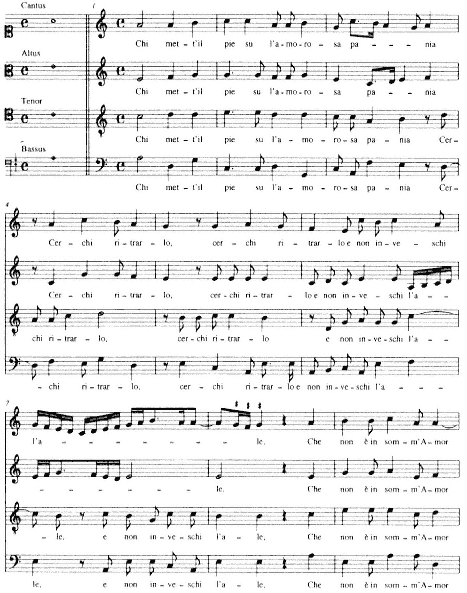
Ex. 52.
Perissone, Chi mett'il pie su l'amorosa pania (Ariosto), incl.;
Primo libro a 4 (Venice, 1547), no. 7.
(continued on next page)
(continued from previous page)
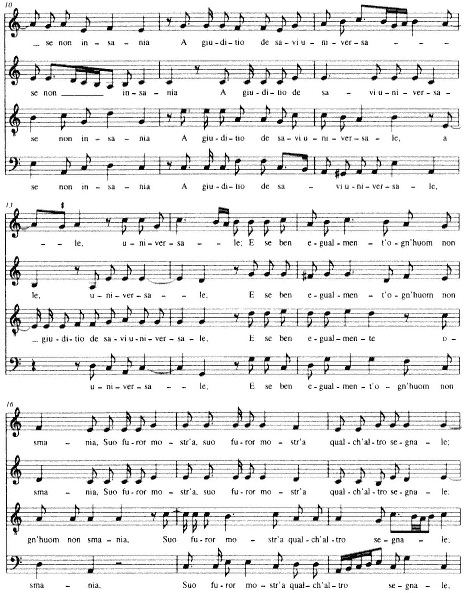
Ex. 52
(continued)
(continued on next page)
(continued from previous page)
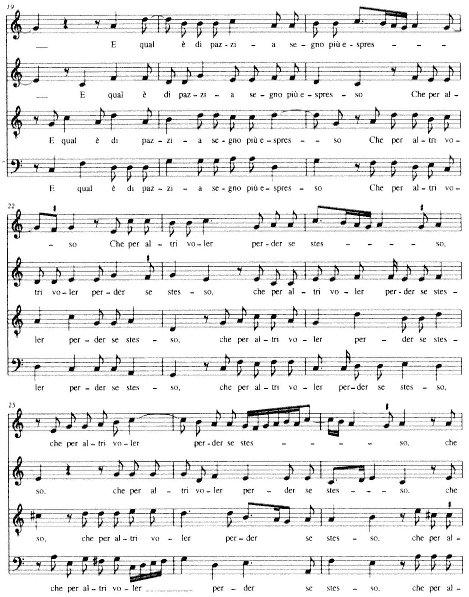
Ex. 52
(continued)
(continued on next page)
(continued from previous page)
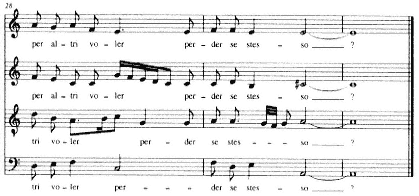
Ex. 52
(continued)
up the fortuitous merging of written contrapuntal with oral soloistic procedures that Perissone effects in settings like this.
Perissone's four-voice settings of madrigals avoid the signs of oral recitation that mark his ottava settings, though without aiming for a higher literary tone. Madrigals elicit more extensive text repetition and far more radical displacements of poetic lines between contrapuntal parts. (In no. 10, for example, the tenor is nearly three measures and fully one poetic line ahead of all three other voices by the end of m. 6.) Instead of playing a continuously harmonic role, bass lines in madrigal settings are inclined to alternate between two roles, that of harmonic support and that of equal participant in the imitative processes governing the whole texture.
Many of the madrigal texts are addressed directly to women in the form of serenades: Vaga tranquilla e lieta (no. 2, to a "Marina"), Duo più potenti lumi (no. 6), and Chiara luce serena (no. 8). Moving away from the sectionalizing strategy of the frot-tola, Perissone's settings give a continuous musical development to their amorous conceits, which invariably crest in a witty point at the end, rather than "[touching on] the principal motif . . . in the first line" or an opening ripresa, as happens in barzellette.[62] According to Parabosco (as he has Speroni declare in I diporti ), both madrigals and strambotti resemble epigrams in sharing this sort of development.[63] Whereas Perissone's ottava settings reproduce the segmented techniques of solo recitation and rely on rhythmic energy for momentum, his madrigal settings mirror their poems' rhetorical trajectory by piling up voices, displaced in imitation, into a contrapuntal crescendo.
[62] The quote is from Einstein, The Italian Madrigal 1:185.
[63] "Above all else," he writes, "the madrigal and strambotto must have a lovely wit and invention, just like an epigram" (sopra ogni altra cosa, il madrigale e lo strambotto vuole andare vago d'arguzia e di invenzione, sì come apunto vuole apparire il motto); I diporti (Venice, [ca. 1550]; repr. in Novellieri minori del cinquecento: G. Parabosco — S. Erizzo, ed. Giuseppe Gigli and Fausto Nicolini [Bari, 1912]), p. 177; a longer excerpt, which includes this passage, is quoted and trans. in Einstein, The Italian Madrigal 1:184-85.
Both approaches could draw on aspects of madrigalistic repertories from the 1530s, though in different ways. By contrast, Perissone's sonnet settings a 4 tend toward denser polyphony and more learned diction (if less so than his sonnets set a 5 ). While indebted to Willaert's settings, his sonnets a 4 are less solemn and ample than Willaert's or Rore's settings a 5 or 6 . Perissone's four-voice In qual parte del ciel, for instance, falls short of Willaert's for six voices by twenty-two breves. The prima parte of Willaert's six-voice Pien d'un vago pensier alone is longer than the whole of Perissone's four-voice setting of it (73 and 72 breves, respectively; Willaert's setting lasts 128 breves altogether).[64] Discrepancies like these are to be expected, given that contrapuntal complexities normally increase geometrically as voices are added. But differences also arise because Perissone tended to make his four-voice sonnet settings lighter, more condensed, and simpler in construction, with voices more frequently arranged in homophony or closely interwoven, and with somewhat less radically evaded cadences than Willaert did.[65]
Perissone's setting of the sonnet Più volte già (no. 14) embodies many of these differences. Like In qual parte del ciel and Pien d'un vago pensier, the setting is much shorter than Willaert's, with each line normally stated once, or at most repeated only partially. Whereas Willaert's exposition of Più volte già opened the a - and o - laden first verse in a languorous, irregular point of imitation, Perissone's opening ascends in chansonlike dactyllic tetrachords located in a regularized, efficient exposition (Exx. 53a and 53b). Willaert ambles through six breves before accelerating into a minim pace; Perissone establishes the minim as the basic declamatory pulse in the first measure. Perissone returned to this laconic style for the polysyndetonic vv. 6 and 7: (Exx. 54a and 54b): "Per ch'ogni mia fortuna, ogni mia sorte, / Mio ben, mio male, et mia vita et mia morte" (for all my fortune, all my destiny, my good, my ill,
[64] Overall the four-voice settings in the Musica nova average about the same length as those for more voices and are about half again as long as the four-voice sonnet settings of Perissone.
[65] On works in the Primo libro a 4 that are modeled on settings in the Musica nova — In qual parte del ciel and Amor, da che tu voi — see Helga Meier, "Zur Chronologie der Musica Nova ," pp. 84-87, and the preface to idem, ed., Fünf Madrigale, pp. iii-iv. The latter, she notes, is unique for borrowing its exposition (like Perissone's five-voice setting of the same poem, published in 1550) not from a setting by Willaert of the same text but rather from one that merely begins with the same word, Amor, fortuna, et la mia mente. Perissone's habit of modeling took a unique form in his four-voice setting of In qual parte del ciel, which borrowed extensively only after the exposition. Meier cites two of these borrowings, one in the motive at v. 3, "Quel bel viso leggiadro" (mm. 18-20; cf. Willaert, mm. 18-21), and the other in the latter half of v. 5, "in selva mai qual dea" (mm. 33-35; cf. Willaert, mm. 36-47). In addition to emphasizing a C tonality, other correspondences may be cited as follows: Perissone's adoption of various aspects of Willaert's interpretation of v. 6, "Chiome d'oro sì fino a l'aura sciolse?" (Perissone, mm. 35-40; Willaert, mm. 45-52); the polymetric combination of tonic and agogic accents on the initial syllable "Chio-" of "Chiome d'oro"; and motivic similarities throughout the respective settings of vv. 12 and 13. The opening of the seconda parte, while not taken over as precisely in Perissone's version a 4 as in that a 5 , nonetheless borrows both the rhythm and general melodic direction of Willaert's original. Willaert's five opening sonorities — A-D-G-C-a — are also all present. Though Perissone reverses the order of the first two, he was apparently reconciling a harmonic imitation of Willaert's setting with the exigencies of his counterpoint, transposing A and D to permit a smooth transition from the prima parte and retain Willaert's colorful C-sharp on "divina" in the uppermost voice. This allowed him to adopt much of the sonority of Willaert's passage despite using a different mode. On the whole Perissone's setting is more tuneful and melodically more far-ranging than its model. In the exposition, for instance, where Willaert's opening is plain, full of repeated notes in small ambituses and devoid of rhythmic surprise, Perissone's lines sweep quickly over large areas of pitch space.

Ex. 53A.
Willaert, Più volte già, dal bel sembiante humano (Petrarch, no. 170),
mm. 1-11; Musica nova (Venice, 1559), no. 6.
my life, and my death). Where Willaert had assigned a separate gesture to each rhetorical parcel, casting "mio ben/mio male" into a kind of dialogue (altus-tenorquintus-bassus, mm. 47-49, answered by cantus-altus-tenor-quintus, mm. 49-51) and drawing out "e mia vita, e mia morte" in a madrigalistic rendering, Perissone set the same clause more plainly (mm. 38-41), phrasing the entire chain of possessives, save "mia fortuna," in a single, quasi-continuous gesture (mm. 31-41). Only the final verse broadens out through a series of textual repetitions marked by perfect cadences (mm. 76 and 84, as traditionally happens toward the end of a madrigal), and finally syncopated embellishment in the tenor.
It thus seems clear that Perissone's less expansive approach to sonnets reflects a continued tendency to view the four-voice madrigal as a qualitatively different
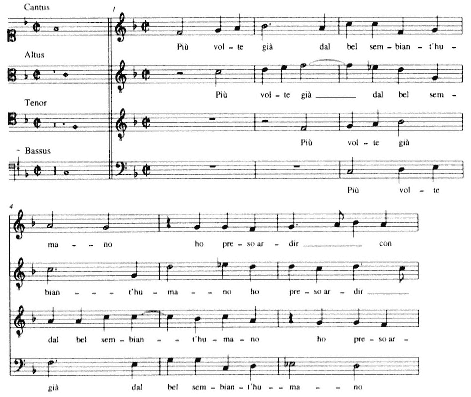
Ex. 53B.
Perissone, Più volte già dal bel sembiant'humano (Petrarch, no. 170),
mm. 1-6; Primo libro a 4 (Venice, 1547), no. 14.
genre from madrigals for five or six voices or those for seven or eight. Yet his Più volte già also conforms to many other instances in which Willaert's disciples hesitated to embrace completely the restrictive seriousness that Willaert brought to Musica nova madrigals.
Although Perissone's career as chapel singer and freelancer continued to flourish in the 1550s,[66] no further collections devoted to his music have come down to us after that of 1550. A few of his works were anthologized up until 1576, but sometime during the 1560s Perissone passed away.[67] His death was mourned in Petrarchan tropes exchanged by two Venetian academists, Domenico Venier and Girolamo Fenaruolo: "The sound
[66] See Jonathan Glixon, "A Musicians' Union in Sixteenth-Century Venice," JAMS 36 (1983): 409-10 n. 42, and Ongaro, "The Chapel of St. Mark's," pp. 140-41 and 145.
[67] See the mentions of his death in documents from the Scuola di San Marco and the Scuola di Santa Maria della Carità reported by Glixon, "A Musicians' Union," pp. 409-10 n. 42. He may have died earlier than the late sixties, as suggested by his absence from the lists of singers at St. Mark's from 1562; see Ongaro, "The Chapel of St. Mark's," p. 165 n. 194, and Document 272.
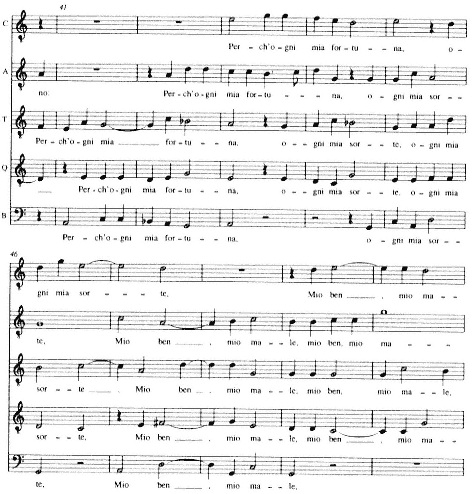
Ex. 54A.
Willaert, Più volte già dal bel sembiante humano (Petrarch, no. 170),
mm. 41-50; Musica nova (Venice, 1559), no. 6.
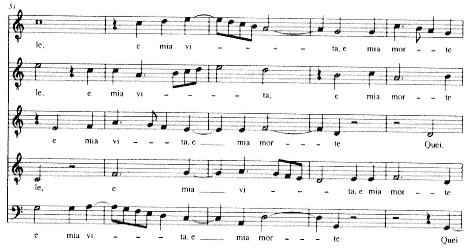
Ex. 54A
(continued)
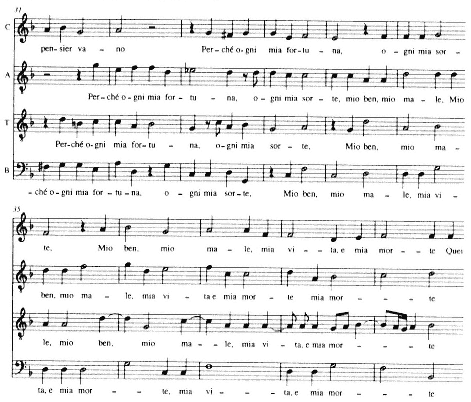
Ex. 54B.
Perissone, Più volte già dal bel sembiant'humano (Petrarch, no. 170),
mm. 31-41; Primo libro a 4 (Venice, 1547), no. 14.
of his sweet tones stopped / the waves in the sea, the wind in the air, / burned ice, moved mountains, and made serene the clouded sky."[68]
Baldassare Donato, Madrigals to 1553
We have already glimpsed Baldassare Donato several times in previous chapters — Donato the maturing choirboy who gained favor in the salons of Venice, was made right-hand man to Willaert, and informant to the Procuratori. Donato's beginnings are in some respects an inverse reflection of Perissone's. Whereas Perissone entered San Marco only in 1548 after several years of scrambling to publish and to perform under private aegises, Donato was already mounting the chapel hierarchy at a comfortable pace by 1545-46, in his mid- to late teens. Yet neither of the prints that unveiled the Venetian school in 1544 — Doni's au courant Dialogo della musica or Rore's Secondo libro — showed any sign of him. Donato's first published work appeared only with Scotto's edition of Rore's Terzo libro of 1548 when Donato was about eighteen to twenty-two years old — still young but hardly precocious by the standards of a Parabosco.[69] Unlike Perissone's compositional career, then, Donato's seems to have been hatched directly from his breeding in the chapel.
Donato's first published madrigal was a setting of Petrarch's sonnet S'una fed'amorosa, un cor non finto (no. 224) that showed him already adept in the diction and counterpoint reserved for sonnets.[70] Petrarch's poem, compounded of seven conditional clauses resolved only in the final verse, deploys a rhetorical strategy ready-made for the continuously woven polyphony and slight motivic variation developed by Willaert. The entire sonnet consists of a large paratactic chain, reinforced by anaphora and structured by linking together in additive series several of its ubiquitous "if" clauses. Since the verb of the main clause is postponed all the way until v. 13, the poem's essential form can be gleaned from the opening and closing lines (1-4 and 12-14):
S'una fed'amorosa, un cor non finto, If faithfulness in love, an undeceiving heart,
Un languir dolce, un desiar cortese, A sweet languishing, a courteous desire,
S'honeste voglie in gentil fuoc'accese, If virtuous longings kindled in a noble fire,
S'un lungh'error in cieco laberinto . . . , If a long wandering in a blind labyrinth . . . ,
. . . . . . . . . . . . . . . . . . . . . . . . . . . . . . . . . . . . . . . . . . . . . . .
S'arder da lunge et agghiacciar da presso, If to burn from afar and freeze close by
Son le cagion ch'amand'io mi distempre, Are the reasons that I untune myself with love,
Vostro, Donn', è'l peccato et mio fia il danno. Yours is the wrong, Lady, and mine may be the loss.
[68] The words are Venier's; see the Appendix to this chap.
[69] On Donato's age I follow Ongaro, "The Chapel of St. Mark's," who thinks he was probably on the younger side of the four-year span given.
[70] For a full transcription see my "Venice and the Madrigal in the Mid-Sixteenth Century," 2 vols. (Ph.D. diss., University of Pennsylvania, 1987), 2:656-67.
In setting this sonnet Donato appealed to the plainest possible motivic idiom, avoiding individual semantic emphasis in favor of a language that would play up the poem's local syntactic and rhetorical differentiations while still countering any pull toward articulation. The setting's dearth of syncopation or sustained progressions by fifth and its proliferation of two-note declamatory groups help check the possibility of any forceful approaches to cadence. The entire setting uses only one diminished cadence: it takes place at the end of the first couplet, but with textual and contrapuntal cadences displaced from one another (see mm. 14-16 in Ex. 55) and only the cantus's noncadential bb-flat sharing the text with the cadencing contratenor. The only other cadences in the first quatrain fall at the end of v. 4, both simple cadences, the first (mm. 26-27) emphasized with an f-sharp in the cantus, the second with an undiminished half cadence (mm. 31-32).
All of this contrasts greatly with Donato's madrigalian settings from his first solo collection of 1550, a medley of light madrigals for four voices and canzoni villanesche alla napolitana published as Le napolitane, et alcuni madrigali a quattro voci.[71]Le napolitane points up the loose affinity of villanesche with lighter four-voice madrigals, both of which profited from Donato's natural gifts for vivid, animated rhythms and sharply etched melodies. None of the madrigals in it are sonnet settings. Indeed the opening number, Vaghi pensier che così passo passo, setting the third stanza from Petrarch's canzone no. 70, serves as a reminder that single canzone stanzas — even Petrarch's — were thought of by composers in a way more akin to poetic madrigals than to weightier sonnets (as poets conceived them).
Vaghi pensier is a compact mix of endecasillabi and settenari. With its emblematic lament on the stony lady culminating in the famous incipit from Dante's Rime petrose, it must have made good capital with literary-minded book buyers. (The stanza had already been singled out for musical treatment by Parabosco four years earlier; see Table 9, no. 16.)
Vaghi pensier che così passo passo Yearning thoughts, which thus step by step
Scorto ma'havet'a ragionar tant'alto; Have led me to such high speech:
Vedete che madonna ha 'l cor di smalto You see that my lady has a heart of such hard
Sì forte ch'io per me dentro no 'l passo. Stone that I cannot by myself pass within it.
Ella non degna di mirar sì basso She does not deign to look so low 5
Che di nostre parole As to care about our words,
Curi, che 'l ciel non vuole, For the heavens do not wish it,
Al qual pur contrastand'io son già lasso; And resisting them I am already weary;
Onde come nel cor m'induro e 'naspro, Therefore as in my heart I become sad and bitter,
"Così nel mio parlar vogli'esser aspro." "So in my speech I wish to become harsh." 10
[71] The print also included villotte by Perissone. The last three numbers in it are Donato's settings of Venier's stanzas in praise of Venice (see Chap. 4 nn. 78-79).
Between publications of S'una fed'amorosa in 1548 and Le napolitane in 1550 Donato published a single ottava setting, O felice colui ch'al suo volere, in Scotto's Fantesie, et recerchari a tre voci, accomodate da cantare et sonare . . . con la giunta di alcuni altri Recerchari, et Madrigali a tre voci of 1549 (1549 ), a print that includes works by Willaert, Rore, and others. (Einstein's statement that this was the first appearance of Donato's music in print is of course incorrect; The Italian Madrigal 1:448.)
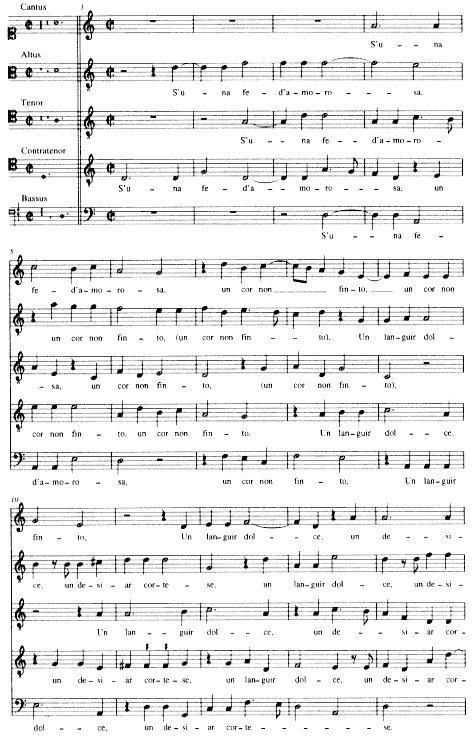
Ex. 55.
Donato, S'una fed'amorosa, un cor non finto (Petrarch, no. 224),
mm. 1-32; in Cipriano de Rore, Terzo libro a 5 (Venice, 1548) (RISM 15489 ), p. 13.
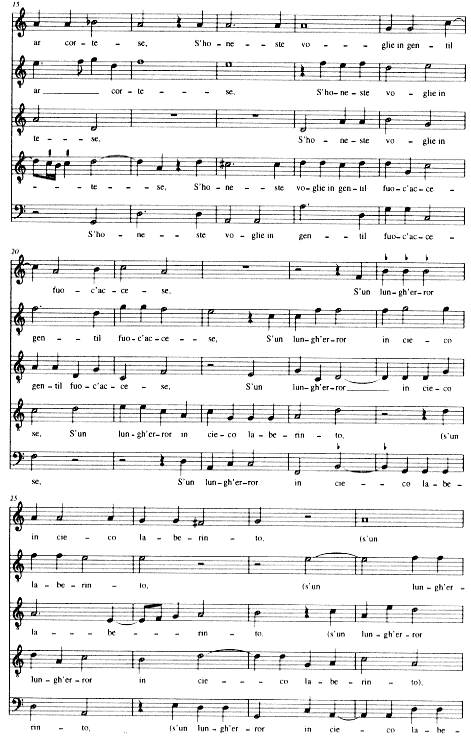
Ex. 55
(continued)
(continued on next page)
(continued from previous page)
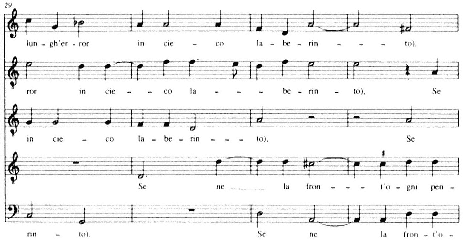
Ex. 55
(continued)
Donato's style here so much avoids the heavier manner of Willaert's and Perissone's sonnet settings that Einstein likened it to that of the young Palestrina.[72] Sealing off the four lines of piedi with a sectional break, Donato recognized the stanza's segmented character, as earlier madrigalists had done in setting canzoni and ballata-madrigals, and also (like them) built his setting out of crisp, short phrases and a metrically uniform imitative technique. Cadences like the ones in Ex. 56 assemble the voices in homorhythmic declamation (mm. 38, 43, and 48), or else they converge successively by pairs.
Donato's generally careful declamation helped project the stanza formally, rather than elaborating it rhetorically, but he also embellished the text in line with the lighter traditions that especially suited his natural gifts. Thus, for example, the end of v. 3 ignores declamatory demands altogether, applying a graceful decorative melisma in the manner of chansonesque madrigals. Following the lead of Rore's recent Vergine bella setting (and unlike Willaert's madrigals), voices do not always sing the complete stanza, but often drop out to reduce textures epigrammatically without reinstating omitted text. Donato lingers only for formal reasons, like the standard reiteration of the last line. This is one place, at Petrarch's deft elision into Dante's text, where a more arduous rhetoric might be expected, but Donato ventures nothing but a few consecutive six-three chords on "aspro" and a single four-three appoggiatura. If Donato's S'una fed'amorosa avoided semantic intensity in favor of sober recitation, Vaghi pensier avoids it to preserve an air of light lyricism.
[72] The Italian Madrigal 1:452. For a complete transcription see Feldman, "Venice and the Madrigal," 2:668-76.

Ex. 56.
Donato, Vaghi pensier, che così passo passo (Petrarch, no. 70, stanza 3),
mm. 32-48; Le napolitane, et alcuni madrigali a 4 (Venice, 1550), p. 1.
Donato's first full-fledged print of madrigals was not issued until 1553, under the title Il primo libro d'i madregali a cinque & a sei voci, con tre dialoghi a sette.[73] The book bore a mysterious and intriguing dedication to one Cardinal of Sant'Angelo, whom Donato called his "sole benefactor."
To the most Illustrious and Reverend Monsignor, Cardinal of Sant'Angelo, my sole Lord and Benefactor. Baldassara Donato.
Most Illustrious and Reverend Monsignor, my most honorable patron: Two symbols used to be specially assigned by the ancients to the sun, the bow and the lyre — the bow because with the arrows of its rays it [both] strikes and gives life to everything; the lyre because, placed in the midst of all the other planets, almost as the norm and temperament of all the others, it guides the softest and the grandest celestial harmony. But we, owing to our disproportioned senses, fail to hear it. It is fitting that the moderns should give the same to Your Most Illustrious and Reverend Lordship, sun and ornament of this age — you who with the rays of your many virtues and with your splendor and that of your ancestors manifest and kindle everything and who with your lyre of internal reasoning and prudence so well harmonize the affects of your soul in the midst of the other princes that both in great fortunes past and in the glory of the present one could barely discern which was greater in you, grandeur or charm, happiness or humanity, forcefulness or mildness. Beyond this it will suit you when the time comes to you, taking the place of your most blessed forefathers, to temper amongst all the other princes the harmony of the Christian Republic. Owing to this renown, then, the dedications of works in all fields are due to the name of your Most Illustrious and Reverend Lordship. But those of music are most due to you. My having therefore collected some of my efforts in this science I consecrate them to you, as to their true and appropriate recipient, considering that the virtue of your sacred name must make the harmony of my labors sweeter and more welcome to whomever will hear them. Kissing your sacred hands with this, I pray for you a happiness equal to your merit.[74]
[73] A complete ed. may be found in Sixteenth-Century Madrigal, vol. 10, ed. Martha Feldman (New York, 1991).
[74] ALL'ILLUSTRISSIMO ET REVERENDISSIMO Monsignor, Il Cardinale di Santo Angelo, Signor & Benefattore unico. Baldassara Donato.
Illustrissimo & Reverendissimo Monsignore, Patrone Colendissimo. Due insegne si solevano da gli antichi spetialmente dar al sole l'arco et la cetra: L'arco perche con le saette de suo raggi ferisce & vivifica ogni cosa. La cetra perche posto in mezzo di tutti gli altri pianeti quasi norma et temperamento de gli altri guida la celeste armonia soavissima et grandissima. Ma da noi per la sproportion del nostro senso non udita: L'istesso conviene che moderni dieno a Vostro Illustrissima et Reverendissima .S. Sole & ornamento di questa età, Il quale co raggi di tante virtu vostre, & dello splendore Avito & proprio illustrate, & infiammate ogni cosa, & con la cetra dell'interna ragione & prudenza accordate in mezzo a gli altri Principi cosi bene gli affetti del vostro animo, che nella maggior fortuna passata et nella grande d'hora mal s'e possuto scorgere qual sia stata maggiore la grandezza, o la piacevolezza, la felicita, o l'humanita, l'amplitudine o la mansuetudine, Oltre che a voi converrà, quando per l'eta vi sarà concesso occupando il luogo del vostro Santissimo Avo temprare fra tutti gli altri Principi l'armonia della Christiana Republica: Per questo nome dunque le dedicationi de componimenti in ogni scientia sono dovute al nome di Vostra Illustrissima & Reverendissima .S. Ma quelle della Musica le sono dovutissime: Havendo io per tanto raccolte alcune mie fatiche in questa scienza le consacro a lei come ad obietto loro proprio et adequato: Considerando che la virtu del vostro sacro nome dovra render piu dolce & piu aggradevole l'armonia di queste mie fatiche a chiunque le udira, & basciandole con questo le sacre mano le prego felicita eguale al suo merito.
Though signed by the composer, Donato probably could not have crafted such an extended Neoplatonic conceit without the aid of an acquaintance or house editor versed in letters (if indeed he authored it at all). The language seems designed to complement august aspects of the book itself, with its full panoply of five-, six-, and seven-voice works (twenty-six in all), its sumptuous stylistic and topical variety, and its several ceremonious dedicatory works.
Given this, it is fitting to realize that the Cardinal of Sant'Angelo is identical to Ranuccio Farnese (1530-1565), member of the powerful Farnese family who ruled Parma from 1545. Remembered today especially for the famous portrait of him painted by Titian in 1542 (Plate 20), Ranuccio was the son of Parma's first duke Pierluigi Farnese, grandson of Alessandro Farnese (better known as Pope Paul III) and a cardinal from the age of fifteen.[75] Corroboration of his identity comes in the print's inaugural piece, which gives his Christian name in the variant Rinuccio, together with various allusions to the family's history and the fleur-de-lis on its coat of arms.[76]
Mentre quest'alme et honorate rive While you make these life-giving
Co' tuoi purpurei gigli And honored shores bloom
Fai fiorir d'ogn'intorno, All about with your purple lilies,
Rinuccio, de le cose al mondo Dive, Rinuccio, divine among the things of the world,
Odo il tuo Tebro e'l sacro Vaticano, I hear your Tiber and your sacred Vatican 5
Quasi un de suoi più chiari et degni figli, Sighing for you, almost as one of their
Sospirarti lontano, Worthiest and most eminent sons, far away,
Pur attendendo il dì del tuo ritorno, And still awaiting the day of your return,
Sperando l'un le sponde Hoping to see fertile again,
L'altro le sue pendici The one its banks, the other its slopes, 10
D'Olive et palme riveder feconde, With olives and palms,
Quai le fer già le tue sante radici, As your holy roots already make them,
Et de tuoi gigli tutta Italia et Roma And all of Italy and Rome [hoping]
Ornarsi anchor la gloriosa chioma. To crown themselves gloriously with your lilies.[77]
Nothing is known of Ranuccio's relationship to Donato and the Primo libro a 5 & a 6 apart from this book. Perhaps Donato came to the attention of the Farnese family through Willaert, whose setting of the sonnet Mentre al bel lett'ove dormia Phetonte,
[75] See the genealogy in Emilio Nasalli Rocca, I Farnese (Varese, 1969), Table II and p. 108, which explains that Ranuccio came to be called "Sant'Angelo" for the name of his church. See also the Table in Edoardo del Vecchio, I Farnese, Istituto di Studi Romani (Città di Castello, 1972), and on Ranuccio, pp. 107ff. On Titian's portrait and its subject see Harold E. Wethey, The Paintings of Titian: Complete Edition, 2 vols. (New York, 1971), vol. 2, The Portraits, pp. 98-99, and Plates 109 and 111-14, including details. See also Georg Gronau, "Zwei Tizianische Bildnisse der Berliner Galerie: I, Das Bildnis des Ranuccio Farnese; II, Das Bildnis der Tochter des Roberto Strozzi," Jahrbuch der königlich preuszischen Kunstsammlungen 27 (1906): 3-12.
[76] For a description of the Farnese arms see G. B. di Crollalanza, Dizionario storico-blasonico delle famiglie nobili e notabili italiane estinte e fiorente, 3 vols. (Pisa, 1886-90; repr. Bologna, 1965), 1:392, and for the arms showing the lilies described in the poem, Lina Balestrieri, Feste e spettacoli alla corte di Farnese, Quaderni parmigiani, no. 6 (Parma, 1981), front matter.
[77] My translations of this poem and the dedication were much aided by advice from Linda Armao.
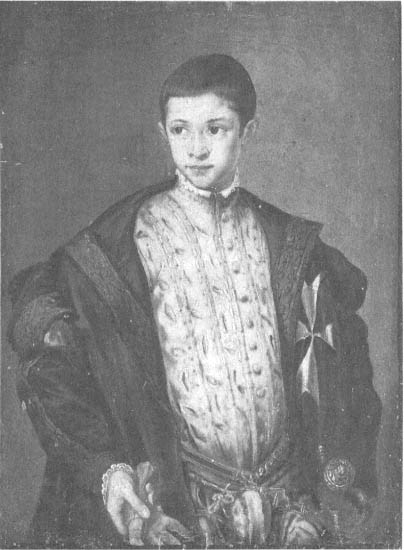
20.
Titian, Portrait of Ranuccio Farnese, 1542.
Photo courtesy of the Gemäldegalerie, Staatliche Museen
Preussischer Kulturbesitz, Berlin.
published in 1548, appears to celebrate the heroics of Ranuccio's father, Pierluigi, on the occasion of the Farnese's takeover of Parma and Pierluigi's assumption of Parma's dukedom in September and October 1545.[78] Other texts in Donato's book celebrating famous families may form part of a complex of tributes to the Farnese (though none of these has the positive markers of Mentre quest'alme ). The ottava rima Pianta beata,
[78] The setting was published in Rore's Terzo libro a 5 (RISM 15489). The identification of the poem's probable occasion and dedicatee was made by Helga Meier in her edition of Willaert, Opera omnia, vol. 14, Madrigali e Canzoni Villanesche, AIM (Neuhausen-Stuttgart, 1977), p. x.
che già fosti degna (no. 18), in particular, exalts the "Fronde de vincitor felice insegna / A cui fan sempre i più bei spirti honore" (branch of the victor, happy insignia, to which the most beautiful spirits always pay homage). Later it calls up the "Rami sacri felici almi'et beati" (sacred branches, happy, life-giving, and blessed) as part of a final two-verse acclamation that occupies nearly half the length of Donato's setting. The final dialogue, "Ahi miserelle, ahi sventurate noi, " celebrating Pluto, Proserpina, and Hymen, probably evolved as an intermedio that formed part of a staged wedding celebration. Only Italy's wealthiest families, like the Farnese, typically produced such celebrations, but no positive clues of a connection to them exist.[79]
Following roughly the form of the Musica nova, Donato's Primo libro a 5 & a 6 contains seventeen five-voice madrigals, six six-voice madrigals, and three seven-voice dialogues, in no traditional modal order (see Table 13). Surely the desire to position the dedicatory madrigal at the book's opening and order its madrigals by numbers of voices superseded modal concerns. Nevertheless, like nearly all Gardane's prints, Donato's book groups works with like pitch systems — hence nos. 4-6 are all in cantus durus on E, nos. 10-13 all share the type

The Primo libro a 5 & a 6 stresses sonnets, but not to the exclusion of other poems. Half of the book's twenty-six numbers are sonnet settings, only ten of them complete. All but one of the complete settings divide after the octave; the single exception, set continuously, is no. 10, on a light May Day text. Otherwise only the dialogues dispense with this two-part arrangement, two of them resetting texts from the Musica nova (nos. 24 and 25). The remaining thirteen works divide between cinquecento poetic madrigals (nos. 1, 11, 15, 19, and 26), ottave rime (nos. 4, 12, 13, 14, and 18), a canzone stanza by Petrarch (no. 3), and two ballata-madrigals (nos. 16 and 23). In addition to somewhat older poets like the Venetians Andrea Navagero and Pietro Bembo, the book makes notable use of a younger group of poets who were intimates of Domenico Venier's literary salon: Giovanni Battista Amalteo, Lodovico Dolce, and Fortunio Spira. Donato, as we saw in Chapter 4, may have gotten to know Venier when he set his three patriotic stanzas for a public festival in the city (the settings were published as the final three numbers in Donato's Napolitane of 1550), and the sonnet setting no. 9 almost surely celebrated one of Venier's noble academists, Lorenzo Contarini (see n. 79).
Donato's first book shows a facility for counterpoint and melody as endearing as Perissone's and just as fit to win admirers and freelance work from wealthy patrons.
[79] On Ahi miserelle see Einstein, The Italian Madrigal 1:452-53.
One other setting, no. 9, Angelico intelletto hor che nel seno, on a sonnet lamenting the death of one "Contareno," eulogizes another nobleman, a member of the prominent Venetian family also called Contarini. The sonnet's emphasis on the deceased's intellect leads me to think that it referred to Lorenzo Contarini, the philosopher, Latin scholar, and member of Venier's circle, included as interlocutor in Parabosco's I diporti, who died on 8 November 1552; see A. Venturi, "Contarini, Lorenzo," in Dizionario biografico degli italiani, vol. 28 (Rome, 1983), pp. 231-33.
[80] On Gardane's practice of grouping works by some combination of system, ambitus, and/or final see Mary S. Lewis, "Antonio Gardane and His Publications of Sacred Music 1538-55" (Ph.D. diss, Brandeis University, 1979), pp. 184-91. For the argument that Gardane was arranging by tonal type and not mode see Powers, "Tonal Types and Modal Categories," esp. p. 461.
| ||||||||||||||||||||||||||||||||||||||||||||||||||||||||||||||||||||||
(Table continued on next page)
| |||||||||||||||||||||||||||||||||||||||||||||||||||||||||||||||||||||||||||||||||||||
Only rarely, as in his fourth-mode setting of Petrarch's spiritual sonnet I vo piangendo, scored for low male voices, did Donato essay the same dark effects as Willaert. More often his work followed that of other disciples at San Marco in reconciling Willaert's rhetorical lessons with a lighter style, approximating Bembist ideals without clinging to such introverted declamation as Willaert's.
Indeed Donato did so while borrowing from Willaert in less concealed ways than Perissone. His setting of I vidi in terra employs the same tonal type as Willaert's,

But the most striking borrowing comes at the beginning of the seconda parte, where Donato adopted almost every facet of Willaert's composition (cf. Ex. 58a below with Ex. 58b) — the lengthy movement by fifths, the pacing and development of the declamatory rhythm, and even much of the voicing and many of the individual motives. The passage is little more than a rescoring of Willaert's original. Here Donato's imitative practice verges on the kind of submissive reverence contemporary Venetian literati exhorted for imitating Petrarch.[82] The same can be said of both his other resettings of Musica nova texts, the two dialogues "Liete e pensose " and "Che fai alma, " which (again) mimic Willaert in ways that are less camouflaged than Perissone's. For "Che fai alma, " in fact, Donato closely adapted the polyphony of Willaert's entire exposition.[83]
[81] To follow a complete score, see my ed., pp. 214-21.
[82] On this matter see Chap. 5 above and Thomas M. Greene, The Light in Troy: Imitation and Discovery in Renaissance Poetry (New Haven, 1982).
[83] See H. Meier, "Zur Chronologie der Musica Nova, " p. 78. On the concision that typically marks Donato's adaptations see David Alan Nutter, "The Italian Polyphonic Dialogue of the Sixteenth Century," 2 vols. (Ph.D. diss., University of Nottingham, 1978), p. 107.
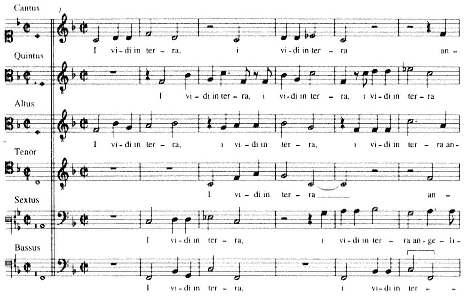
Ex. 57A.
Willaert, I vidi in terra angelici costumi (Petrarch, no. 156),
mm. 1-6; Musica nova (Venice, 1559), no. 19.

Ex. 57B.
Perissone, I'vid'in terra angelici costumi (Petrarch, no. 156),
mm. 1-7; Segondo libro a 5 (Venice, 1550), p. 6.
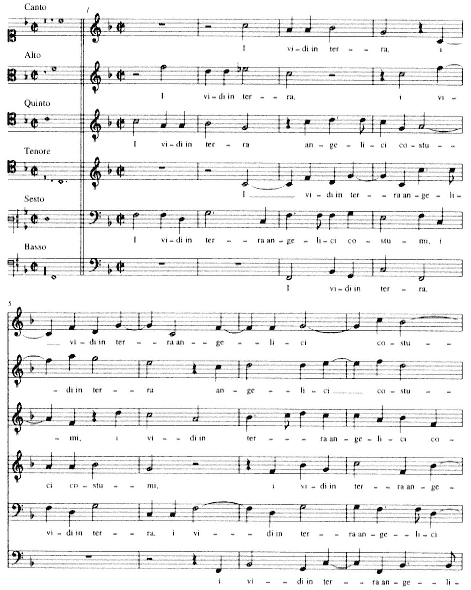
Ex. 57C.
Donato, I vidi in terra angelici costumi (Petrarch, no. 156),
mm. 1-8; Primo libro a 5 & a 6 (Venice, 1560), p. 28.
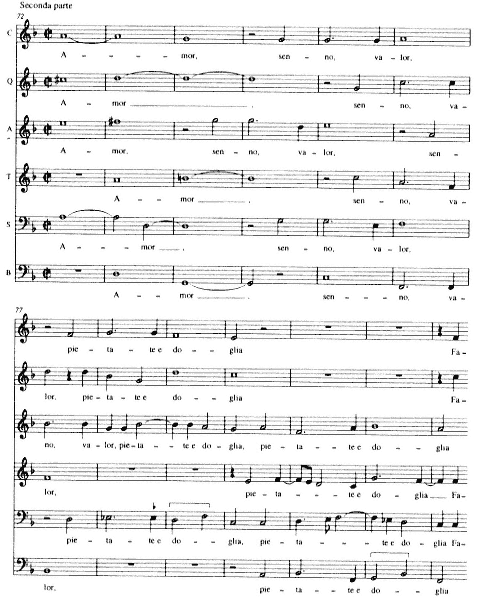
Ex. 58A.
Willaert, I vidi in terra angelici costumi (Petrarch, no. 156),
mm. 72-83; Musica nova (Venice, 1559), no. 19.
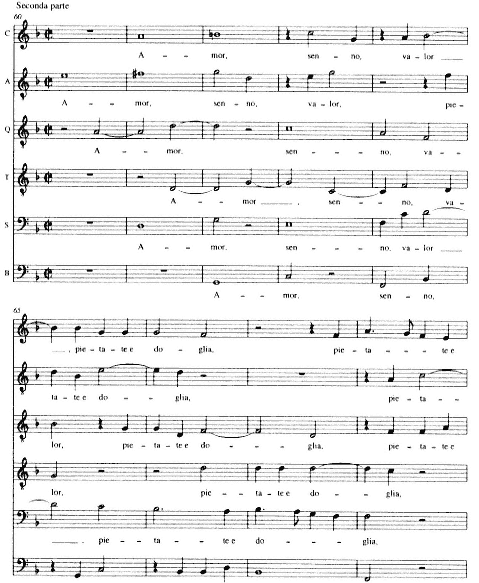
Ex. 58B.
Donato, I vidi in terra angelici costumi (Petrarch, no. 156),
mm. 60-68; Primo libro a 5 & a 6 (Venice, 1560), p. 28.
These are not the sorts of furtive borrowings to thread the counterpoint with witty glosses, perceptible only to the canniest observers. They are servile acts of praise, readily identified by any listener well acquainted with the model. Given Donato's relation to Willaert as both close collaborator and subordinate, it comes as no surprise that his imitations took the form of public homage.
By their simultaneous gestures of overt tribute and self-display, imitations of this kind allow us privileged scrutiny of the public debts disciples paid their masters at the same time as they paradoxically illuminate disciples' styles in nonemulatory works. Donato's setting of Dolce's Scalda, Signor, il mio gelato core (no. 21) forms a case in point. As a spiritual sonnet, Scalda, Signor aligned itself with a pious Petrarchan rhetoric through direct supplications to God, calling for a somber diction as naturally as Petrarch's secular sonnets did. Donato set Scalda, Signor with the same proportions as Musica nova settings, yet asserted his own voice by fashioning a more melodious and metrical exemplar of the spiritual style. Such lyricism is even more surprising in Donato's other spiritual madrigal, on Petrarch's I vo piangendo, a text that he might have set more like Scalda, Signor. I vo piangendo lacked a model in either Willaert or Rore but had a direct antecedent in Parabosco's setting of its octave, published in 1546. Donato's madrigal shows no relation to Parabosco's, except that both use Phrygian mode and avoid chiavette (in fact Donato's dips into the lowest possible tessituras with the cleffing c4c4F3F4F5, as compared with Parabosco's c1c3c4c4F4; cf. Table 9, no. 14 with Table 13, no. 5). In other respects Donato's setting forms a virtual antitype to Parabosco's, collapsing the entire sonnet into a scant 89 breves as against the 104 Parabosco used for the octave.[84]
Once outside the imposing domain of Petrarchan sonnets and close cousins like Scalda, Signor, Donato's knack for pithy execution, distinctive motives, and melodic grace led him to author wonderfully fresh madrigals. In his settings of poetic madrigals, in particular, Donato's stylishness, lyricism, and wit went unsurpassed by his contemporaries. A good example of these melodic gifts is the anonymous Sarra, vostra beltate è tanta e tale (no. II), an encomium to the Sarra apostrophized in the incipit, where Donato's cantus sparkles its way through the plagal octave d to dd, with semiminims lighting down by thirds (mm. 14-15), before reaching the final g (Ex. 59). Another madrigal, Lodovico Martelli's Da duo occhi lucenti (no. 16), unveils the opening conceit on the beloved's "two eyes" with a tongue-in-cheek musical icon: two lone voices in homorhythm. Still other settings — Il primo dì del bel fiorito maggio (no. 10) and the octave of Bembo's Cantai un tempo, et se fu dolce il canto (no. 17) — turn to breezy triple meters and sprightly melismas (note the rhapsodic example of the latter in Ex. 60).
With this playful melodic bent, Donato must have been a great hit in the salons of Venice. Yet not all his 1553 settings of lighter texts are so insouciant — most notably his setting of Spira's ballata-madrigal, Non è, lasso, martire (no. 23).
[84] See Einstein's description, The Italian Madrigal 1:452.

Ex. 59.
Donato, Sarra, vostra beltate è tante e tale, cantus,
mm. 5-18; Primo libro a 5 & a 6 (Venice, 1560), p. 16.

Ex. 60.
Donato, Cantai un tempo, e se fu dolce il canto (Pietro Bembo),
cantus, mm. 30-37; Primo libro a 5 & a 6 (Venice, 1560), p. 22.
Non è, lasso, martire It is not, alas, a martyrdom
Il convenir per voi, Donna, morire, To agree for you, Lady, to die,
Se la cagion de la mia mort'è tale If the cause of death is such
Che fa lieve ogni male; That it lessens every suffering.
Ma quel che mi tormenta But what torments me 5
È che del mio morir sete contenta, Is that my death contents you,
E ch'al primo veder d'altro amadore And that at the first sight of another admirer
Cangiaste 'l vostro core. You changed your heart.
Non è, dunque, martire, Is it not, then, a martyrdom
Il convenir per voi, Donna, morire? To agree for you, Lady, to die? 10
Already in 1545, when Spira's text was published in the first of the Rime diverse series, its form was a throwback to the old madrigal-with-refrain popular with poets like Lodovico Martelli and Dragonetto Bonifazio in the twenties and thirties. Like Bonifazio's Amor mi fa morire (see Chap. 7 nn. 18-19), Spira's poem elides the ripresa 's return by means of a slight rhetorical transformation. In keeping with the poetic device, the music that begins the madrigal returns to end it (mm. 54-72), neatly joined by means of an expressive cross relation, C-sharp/C. However old the setting was in 1553 (it could well have been newly written, or as old as eight or
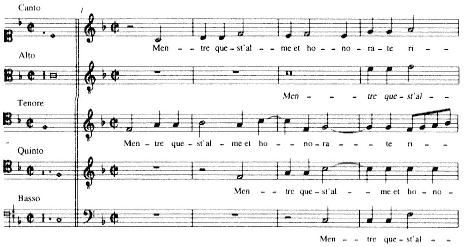
Ex. 61.
Donato, Mentre quest'alme et honorate rive, mm. 1-4;
Primo libro a 5 & a 6 (Venice, 1560), p. 1.
ten years), it resembles Verdelot's six-voice madrigals on similar texts[85] — not only their form but their calm, graceful rhythms. Non è, lasso, martire begins with a chansonesque dactyllic figure and disposes the opening verse with a minimum of fuss, avoiding any syncopation until the cadential figure occurs after eight bars. The metrical regularity of the opening endures throughout, with balanced, lucid expositions introducing each new line of text. Choirs of voices often deliver the text in consort, with even-paced counterpoint declaimed in semiminims (like that setting v. 4), adding a chansonesque metric feel. Apart from the cross relation noted earlier, these steady rhythms accompany a pervasive diatonicism.
Such tonal-rhythmic simplicity is shared by Donato's several celebratory settings, which were probably recent creations. The dedication piece Mentre quest'alme begins with a similar dactyllic figure but in a triadic form appropriate to the enunciatory rhetoric of celebration; and the same figure later opens out more spaciously in the invocation to the dedicatee "Rinuccio" (Exx. 61 and 62). Another occasional piece, Pianta beata, realizes this style of choral celebration more fully through its quick triadic exchanges and clear registral shifts. Like those of Non è, lasso, martire, the rhythmic motives of Pianta beata are simple and square and its soundscape diatonic as well. Yet as an ottava rima, Pianta beata's formal-tonal organization is based on the distich principle. The conjunction of simple diatonicism, motivic simplicity, and ottava form is natural, since historically the form was aligned with declamatory song. Even though, as a six-voice setting, Pianta beata has a fair share of imitative
[85] I refer to those published in the collection of 1541 and reprinted in 1546 [RISM 154619]. See also Verdelot's Madonna, qual certeça on a ballata-madrigal by Bonifazio, in H. Colin Slim, ed., A Gift of Madrigals and Motets, 2 vols. (Chicago, 1972), pp. 379-81, with the text on p. 446.
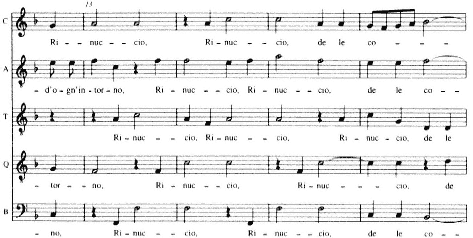
Ex. 62.
Donato, Mentre quest'alme et honorate rive, mm. 13-17;
Primo libro a 5 & a 6 (Venice, 1560), p. 1.
counterpoint, each one of its couplets finishes with a strongly marked cadence joined by at least five of the six voices.
Pianta beata is one of five ottave rime in the Primo libro a 5 & a 6, a higher number than found in any other print in the Venetian repertory. Ottave rime are more at home in Perissone's Primo libro a 4 (the only other print I have dealt with in these chapters to include them, not counting Venier's stanzas in Donato's Napolitane ), since Perissone's four-voice book straddles the fence that separates song from polyphony. By contrast, none of the ottave Donato set in the Primo libro a 5 & a 6, save Pianta beata, looks formally or stylistically different from his madrigals: indeed some seem to merge the rhythmic vivacity of the madrigals with the polyphonic complexity of larger forms. Laura, le selv'et le campagne apriche (no. 12), a gamesmanly series of wordplays on the Laura-Paura homonym, is such an ottava setting, gamboling in widely displaced points of imitation and ebullient declamation.
Unlike any of his peers' collections, Donato's Primo libro was reprinted twice, in 1557 and in 1560. By that time the Willaertian madrigal was already on the wane, and Donato himself published no new books until his first for four voices of 1568. In later years Donato's prestige in the chapel continued to rise as he repeatedly found success in the administrative ranks of San Marco. In addition to regular salary increases, he was made maestro of a newly formed cappella piccola at St. Mark's in 1562,[86] and in 1590 finally became maestro di cappella—a position in which he died
[86] See Ongaro, "The Chapel of St. Mark's," pp. 153-56 and Document 259, on the formation of the cappella piccola, and on Donato's raises in salary, passim.
in 1603, succeeded by the local musician Giovanni Croce. Donato thus takes his place in a neat line of succession from Willaert, Rore, and Zarlino to Monteverdi, who eventually replaced Croce's successor in 1612. His turn toward administration corresponds to the creative trajectory of the madrigal, which had already begun to move out of Venice shortly after Donato published his book. By the mid- to late 1550s exciting transformations of Willaert's style were no longer ventured by composers in Venice but by Rore in Ferrara and, later on, by his students Giaches de Wert and Luzzasco Luzzaschi in Ferrara and Mantua through the 1590s. It is in their works, as well as in those of Luca Marenzio and others, that the lineage of multi-voice madrigals from midcentury can be followed, culminating in Monteverdi's provocative madrigal collections from the turn of the century.
Appendix: Sonnets on the Death of Perissone Cambio[87]
Del Sig. Domenico Veniero In morte di M. Perison Cambio
Musico Eccell.
Ben perì suon, qual suona il nome stesso The sound that sounds the same angelic and
Di cui piangemo, angelico, e divino Divine name for whom we weep perished down there
Qua giuso il dì, che 'l tolse empio destino The day that bitter fate took him away,
E perì tutto il nostro ben con esso. And all our good perished with him. 4
Sol fu per gratia un tempo à noi concesso Such a rare, choice, and uncommon spirit
Sì raro spirto, eletto, e pellegrino, Was only granted us by grace for a time,
Ma troppo hebbe al principio il fin vicino But the end was too close to the beginning
Del viver suo da morte invida oppresso. Of his life, oppressed by envious death. 8
Fermò l'onde nel mar, ne l'aria i venti, The sound of his sweet tones stopped
Arse il gel, mosse i monti, e 'l ciel turbato The waves in the sea, the wind in the air,
Serenò 'I suon de' suoi soavi accenti. Burned ice, moved mountains, and made serene
the clouded sky. 11
Quando egual cambio in cambio à noi fia dato When is an equal change given to us in exchange
Di sì gran Cambio? in van speran le genti, For such a great Cambio? In vain do people hope
Che piu tal dono a lor conceda il Fato. That fate will award them again such a gift. 14
Risposta di Mons. Fenarolo.
Sì mi sento ne l'alma il suono impresso I so hear in my soul the sound made
Di lui, che verso il ciel prese il camino, By him that has taken the path toward Heaven
Che mel par di veder sempre da presso, That I seem to see him always close by,
E fermo il passo, e 'l dolce canto inchino. And I hold my step and bend toward the sweet song. 4
[87] From Rime di Mons. Girolamo Fenaruolo (Venice, 1574), fol. [38].
Poscia avveduto del mio inganno espresso Then realizing my express mistake
Allargo a gli occhi il pianto, e 'l viso chino, I widen my eyes to the tears and bow down my face;
E grido; ahi Cigno gloria di Permesso And I cry, "Oh swan, glory of Permessus,
Perche lasciarmi qui solo, e meschino? Why do you leave me here alone and wretched?" 8
In un punto perì suon sì preghiato, In one moment the sound so esteemed perished,
E 'n sua vece mandò tristi lamenti, And in its place the sea of Hadrian from every side
(Duro Cambio,) il mar d'Adria in ogni lato. (In bitter exchange) sent sad laments. 11
Però, se meco piangi, e ti lamenti, But if you weep and lament with me,
Fai ciò, che chiede il nostro acerbo stato, You do what our bitter state
E la fera cagion de' miei tormenti. And the fierce cause of my torments asks. 14